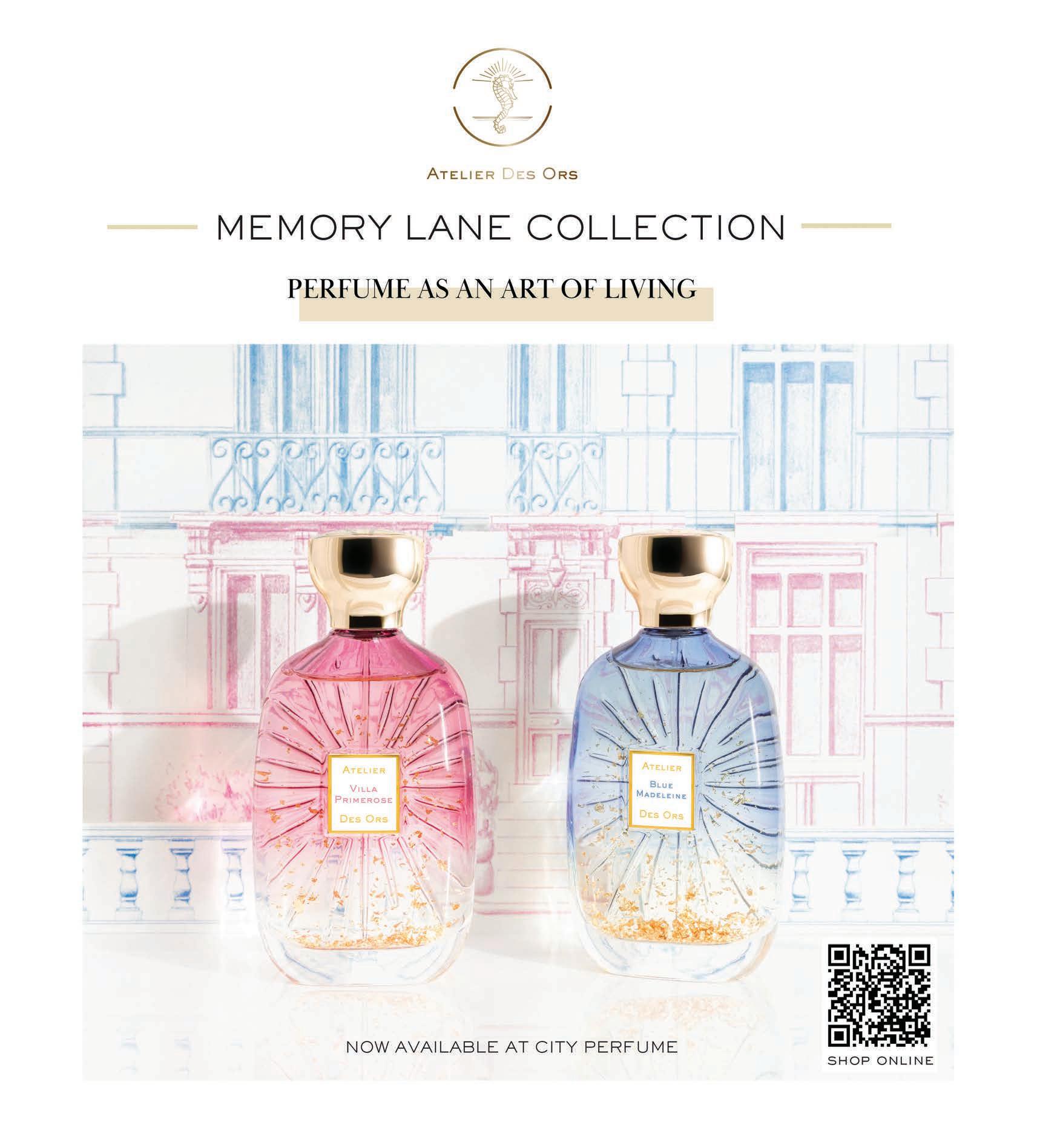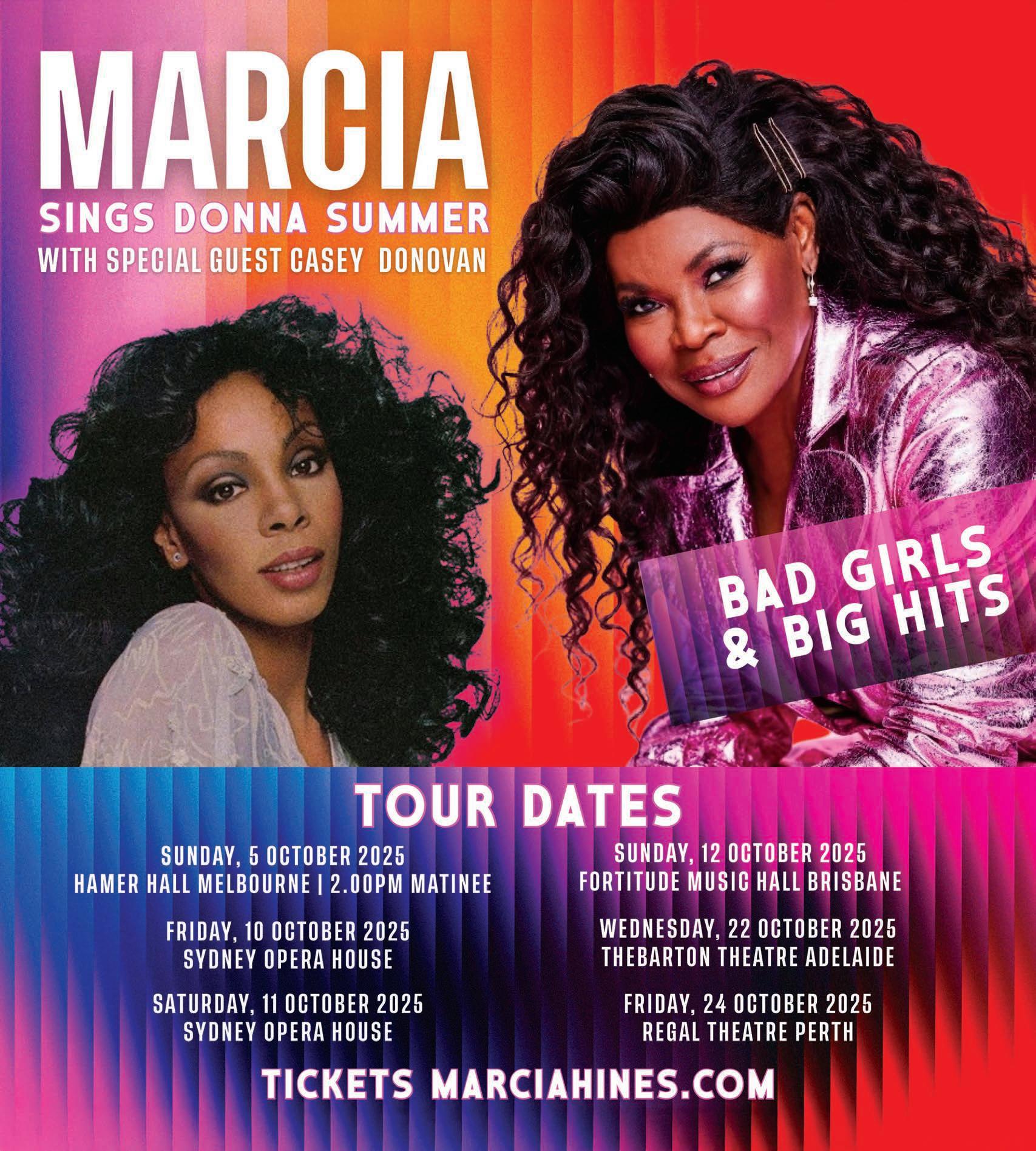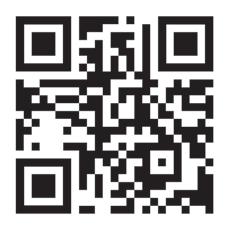



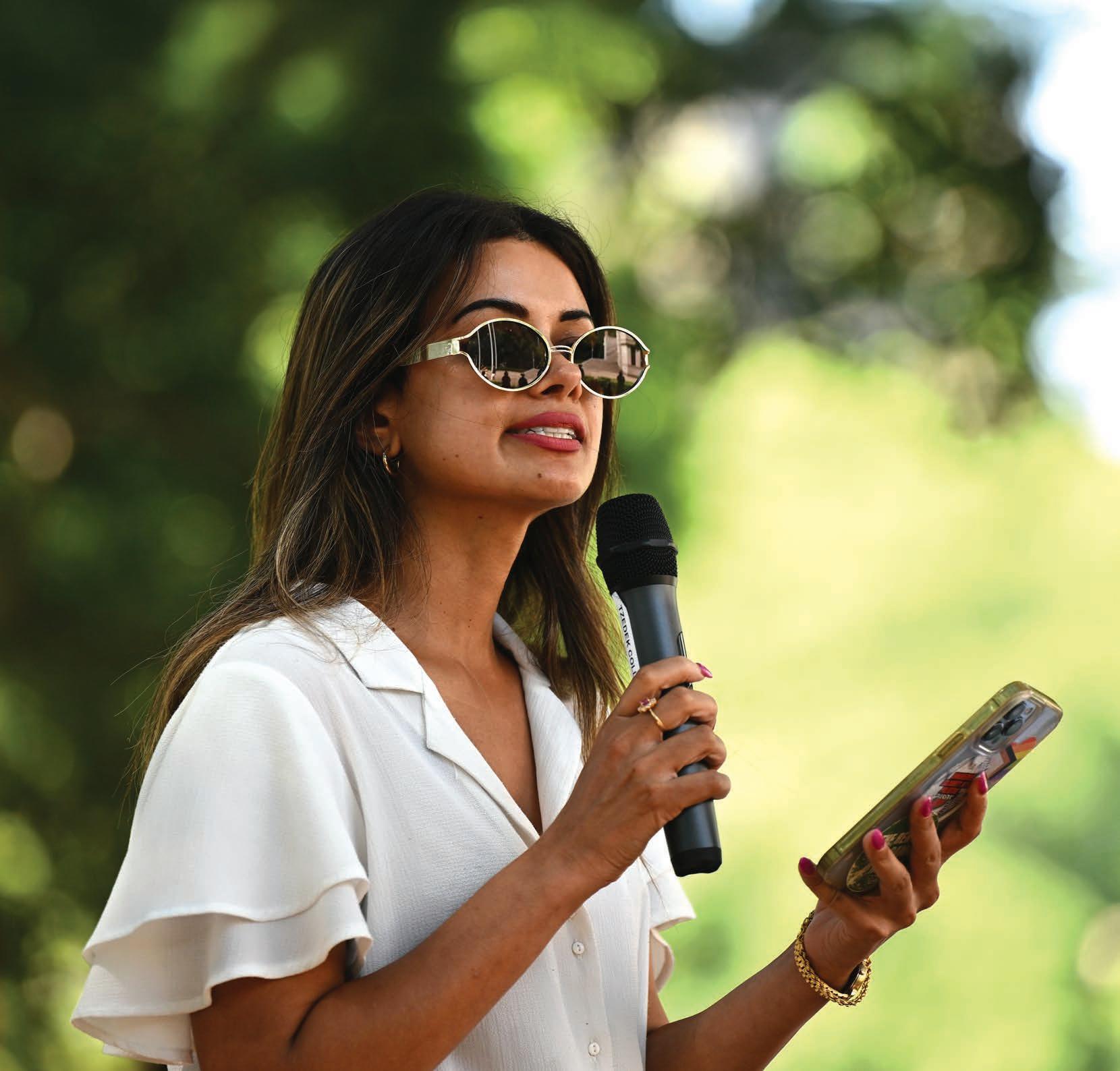








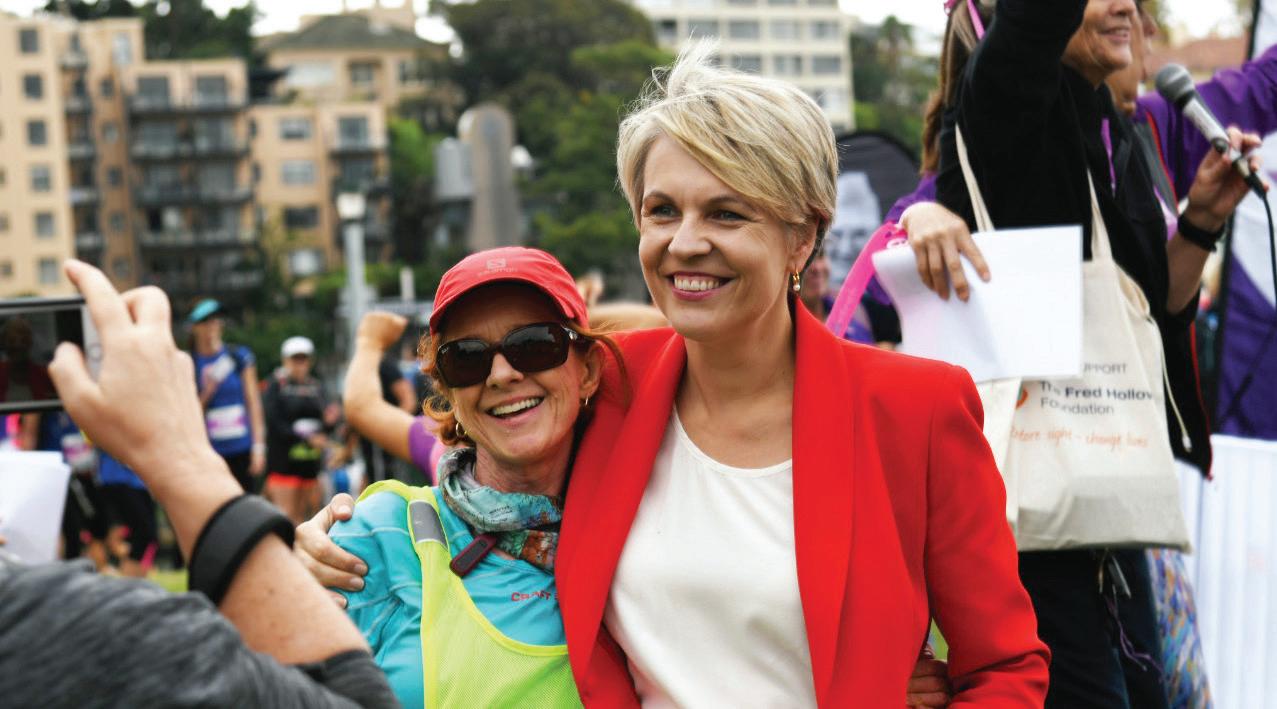
The subsidy is proportionate to the size of the battery installed –ensuring people can choose a battery that suits their needs. For a 11.5 kilowatt hour battery which costs around $14,000, you will save around $4,000. A smaller, 5 kilowatt hour battery costs around $7,000 and will be discounted by around $1,800 under the scheme.
Households with existing rooftop solar will save up to $1,100 on their power bills every year, and those installing a new solar and battery system could save up to $2,300 a year – up to 90 per cent of a typical family electricity bill.
The Cheaper Home Batteries Program is part of our plan to create a fairer, cleaner, and more reliable energy system for all Australians.
To find out more scan here:
We’re also making sure no one gets left behind. We’re upgrading 100,000 social housing properties by installing thermal shell improvements, efficient electric appliances, solar and batteries.
We’re also making solar more accessible to apartments and renters through our Solar Banks program.
To find out more, scan here:
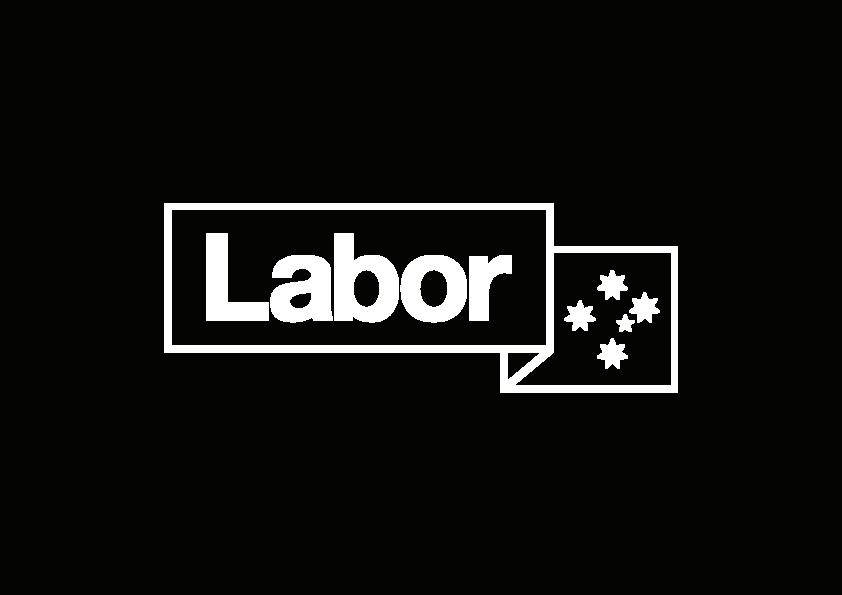
This is in addition to the commitments that we made at the election to help with the cost of living which also began on 1 July including:
Helping up to 2.9 million low income earners by supporting a 3.5 % increase to the National Minimum Wage.
Increasing employers’ minimum compulsory contribution to employees’ superannuation accounts to 12%.
Expanding Paid Parental Leave (PPL) to 24 weeks and increasing amount paid, along with income limits so more families are eligible. Paying superannuation on all Government PPL, so families are about $4,200 better off in retirement.
Delivering $150 rebates for energy bills to every household and to around one million small businesses.
Delivering incentive payments of $10,000 to new tradies who take up apprenticeships in housing construction
In addition to cutting 20% off student loan debts for 3 million Australians, the Government has increased the amount that people can earn to $67,000 before they are required to start paying back their loans, subject to the passage of legislation.
Paid prac for nursing, midwifery, teaching and social work students. Increasing social security payments by 2.4%.
Meanwhile, more responsible cost of living relief will continue rolling out through the remainder of 2025:
Another 50 Medicare Urgent Care Clinics will open in 2025 and bulk billing is expanding from November.
The Government will freeze the indexation of draught beer excise for two years from 1 August.
Hard-working aged care nurses will receive the next instalment of their pay rise in October, following the first instalment in March this year.
Under Labor, inflation is down substantially, real wages are up, unemployment is low, our economy is growing, debt is down and interest rates are falling. It means we are well placed and well prepared at a time of global economic uncertainty and volatility.
But we know people are still under pressure and in our second term, the Albanese Labor Government will continue to help Australians with the cost of living, finish the fight against inflation, strengthen Medicare and build a stronger economy.

BUDGET TIME
Who came out on top in this year's NSW Budget?
(See p.8)
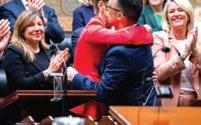
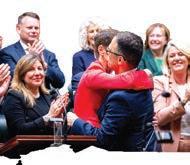
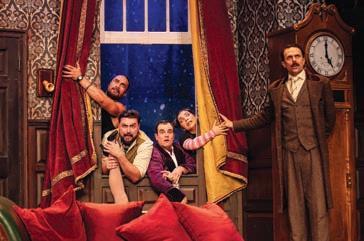
HUBARTS: A MURDEROUS DELIGHT
The Play That Goes Wrong has never been so right (See p.18)
Published monthly and freely available throughout the Inner City.
Copies are also distributed to serviced apartments, hotels, convenience stores and newsagents throughout the city.
Distribution enquiries call 9212 5677.
Published by Altmedia Pty Ltd. While every effort is made to ensure accuracy of content, we take no responsibility for inadvertent errors or omissions.
ABN 52 600 903 348
Group Editor & Publisher: Lawrence Gibbons
Publisher’s Assistant: Mal Moody
National Sales Director: Greg Topalian Ph: 0455 120 404
Advertising Manager:
Mal Moody Ph: 0484 042 615
Advertising: sales@altmedia.net.au
Managing Editor: Chloe Sargeant
News Contributors: Christine Lai, Lydia Jupp, Mae Rawson, Naomi Lawrence, Tara Zhou
Arts Contributors: Coffin Ed, Josh Kerwick, Lydia Jupp, Mark Morellini, Sean CerexheMcIntyre
Cover Photo: Dan Himbrechts / AAP
Designer: Nadia Kalinitcheva
Mail: PO Box 843 Broadway 2007
Email: news@altmedia.net.au, arts@altmedia.net.au
Ph: 9212 5677 Fax: 9212 5633
Website: www.cityhub.com.au
If you have a story, or any comments you’d like to share with us: news@altmedia.net.au
@CityHubSydney
BY MAE RAWSON
Fierce activists and community icons Robert ‘Bobby’ Goldsmith and Ida Leeson have both been commemorated with a Heritage NSW Blue Plaque, which honours and commemorates their lives, and their actions that helped the progression of the LGBTQIA+ community in NSW and beyond.
The Blue Plaques program in New South Wales is a Heritage NSW initiative that shines light on the people, places, and events that have moulded New South Wales for the better.
Initially starting in the UK, the Blue Plaques operates as a historical storyteller, creating a strong link between a person and a place, and providing the public with historical knowledge that should not be overlooked or forgotten. Activists, politicians, as well as the Goldsmith and Leeson’s family and loved ones gathered for separate ceremonies to unveil the plaques on June 30.
For Leeson, her Blue Plaque can be found on the Mitchell Building at the State Library, and Goldsmith’s Blue Plaque can be found outside the Universal nightclub.
Goldsmith's hard-fought legacy started in Hurstville in Sydney, where he was born in 1946.
Goldsmith marched in Sydney's first Gay and Lesbian Mardi Gras in 1978 and
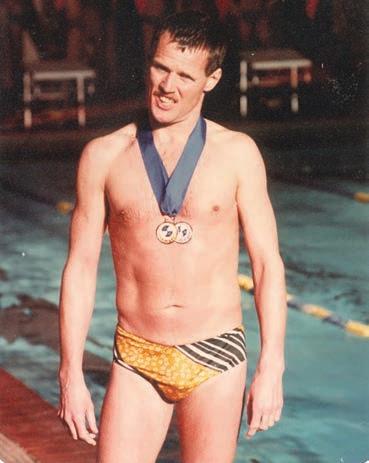
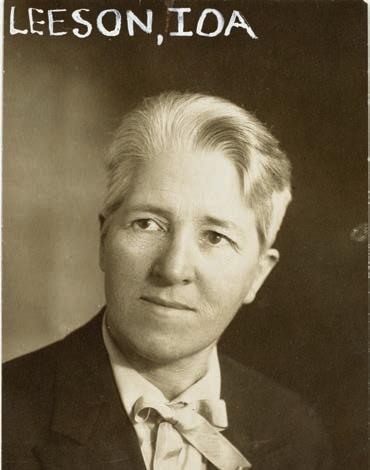
providing community-based care and support to this day.
Ida Leeson’s success catalysed campaigns for equal workplace rights in 1932, after earning a highly respected position at the Mitchell Library. Leeson, an openly gay woman, obtained this success whilst fighting systemic sexism and homophobia, becoming a beacon of hope and strength among women and the LGBTQIA+ community.
Leeson was not only a trailblazer for the LGBTQIA+ community, but her contributions to research, archival management, and historic preservation moulded the library's world-leading Australian Pacific collection.

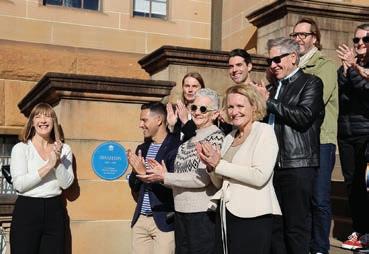
represented Australia at the inaugural 1982 San Francisco Gay Games, winning 17 of Australia's 21 medals.
Just months after competing in the Gay Games, Goldsmith was diagnosed with HIV. Passing away in 1984, Goldsmith’s death was the first publicly acknowledged HIV/AIDS death in New South Wales.
Launched in his name, the Bobby Goldsmith Foundation (BGF) has become Australia's longest-running HIV charity,
"These blue plaques recognise two extraordinary people who have left lasting legacies in progressing women’s and gay rights, and will ensure their stories live on,” Minister for Heritage Penny Sharpe said.
Two extraordinary people who have left lasting legacies in progressing women’s and gay rights
BGF CEO Nick Lawson, who nominated Goldsmith, said, “Bobby Goldsmith’s friends, especially his partner Ken, were instrumental in transforming care for people living with HIV/AIDS.
“Ida’s achievements as a feminist trailblazer living as an openly gay woman in Sydney’s inner west almost 100 years ago are truly remarkable," said Member for Summer Hill, Jo Haylen.
BY LYDIA JUPP
After 16 years serving the community, one of Sydney's most iconic iconic arts, performance, and community spaces, the Rattler, hosted its very own uprising, celebrating resistance through joy.
The queer-run, artist-led venue on the Wongal lands of the Gadigal Nation — aka Marrickville — hosted a fundraiser at the end of June. It celebrated art, storytelling, and survival, to help them hit $30,000 by the end of the financial year, in order to get the space "out of the red" and provide a bit more security for the well-loved grassroots space.
The Red Rattler is an institution unlike any other. One week, their events included the Australian performance debut of Argentinian pop artist Leo García, a writing workshop about resisting erasure led by award-winning writer/poet and human rights lawyer, Sara M Saleh, and the Sydney premiere of Bam Bam: The Sister Nancy Story, a documentary on the legendary Jamaican dancehall DJ.
“One thing that I really love is when I meet people outside of the space and I mention the Red Rattler, quite often, there’s this reaction that’s like, 'Oh my gosh, I love the Red Rattler!'” says Creative Director of the Rat, Afro-Australian performer Kween G.
There is no succinct way to sum up the sorts of events and communities that are lucky enough to find themselves within the walls of the Red Rat, only to say that they wouldn’t want to be anywhere else.
In a relatively short time, the theatre has carved out a place for itself in the history of the queer and alternative art scenes of the country. It played a significant role in Australia’s rapidly growing ballroom scene, holding some of the very first balls organised by Bhenji Ra, Mother of the Haus of Slé. Ra went on to found Sissy Ball, which is now one of the largest balls in the Asia Pacific. The space was also where the late Lebanese-Palestinian queer storyteller and poet, Candy Royalle, gave her final performance alongside her band, The

Freed Radicals, at a monthly poetry night she had been hosting for over a decade.
“I have finally arrived at where I need to be,” she said on the night in 2018.
Once her performance ended, Royalle left the stage and walked through the middle of the crowd, before ascending a flight of stairs and, without turning back, left. She died later that month, aged 37, after suffering from ovarian cancer for years.
conscious art, performance, learning, and community.
The lineup featured the Buuja Buuja Butterfly Dancers, a Wiradjuri dance group fusing traditional and contemporary movement; RaceRage, a queer Blak rapper coming up from Naarm specifically for the event; local DJs like Papi Chulo and DJ (Honey); and the Deputy Leader of the Greens, Mehreen Faruqi, who is no stranger to the Red Rattler stage.
The theatre has a mural dedicated to the artist, and Kween says her energy is embedded in the walls of the building.
“That keeps me going,” she said. “Embodying that political activism is important for us. For community to have space where they where they can be, share, and have a space without having all that red tape saying, ‘oh no, you got to say it like this’.”
With the subheading 'Donate. Decolonise. Dance,' the Red Rattler Upri$ing offered a whole tasting plate of
“It’s hard to bring people in to celebrate when there’s so much chaos and tragedy in the world,” Kween says. She brings up the regular Palestine rallies in the city, and the protests against Black deaths in custody, which have felt sharper since Kumanjayi White’s death at the hands of police last month. Cochair of the Red Rattler, Gumbaynggirr, Bundjalung, and Dunghutti woman Lizzie Jarrett, is a central organiser for many of these through her tireless work with First Nations political organising space, The Blak Caucus.
“We wanted to do something where we, you know, kind of stop and pause and just respect the times we’re in.
"Recognising that we are doing it hard. Let’s come together, and let’s not forget that while we’re trying to manage ourselves, it’s important that we keep this space going.”
The Red Rattler’s EOFY donation link is now closed – and they confirmed to City Hub that they just made their goal, receiving $30,058 in donations.
With the recent announcement that their sister venue, The Bearded Tit, will be closing later in the year, preserving radical art and community venues feels all the more important, especially as political tides around the world are changing rapidly. It may be our right to inhabit spaces that reject racism, homophobia, transphobia, ableism and whorephobia, but in times like these, it’s a stark reminder that these sites were hard fought for.
The parties, workshops, gigs, and lectures that we so often take for granted were once someone’s wildest dreams. If we don’t continue that legacy, we could be without them once again.
“That’s kind of the reason why [we called] it the Red Rattler Uprising,” Kween says. “Because, yeah, we’re saying that we’re not going to go down. We’ve got to stay up.”
BY LYDIA JUPP
An application to list a historically gay beach on New South Wales' heritage list has been rejected, leaving locals feeling angry and disappointed.
Just south of Byron Bay, Kings Beach has been a significant cultural space for local queer communities for at least fifty years, but some documents can trace gay activity on the beach back to the 1930s.
It became especially important during the AIDS crisis in the 1980s, with memorials held there, and the ashes of those who passed scattered on its shores.
The married couple who lodged the application, Rohan Anderson and Jonathan Lee, met at Kings Beach more than ten years ago. They haven't been provided a reason for the rejection.
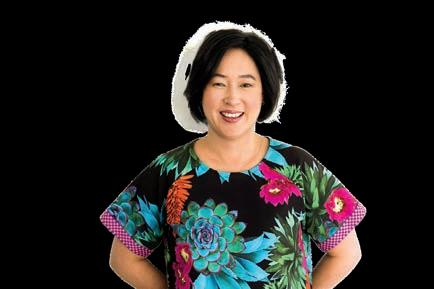

Anderson says NSW National Parks and Wildlife Service (NPWS) has repeatedly ignored the queer history of Kings Beach, and had omitted its strong ties to the gay community in the site's management plan.
"To be left out of the history of the place, is outrageous, really," he told City Hub
"They see us as a problem, other than as a community to celebrate."
Locals were hoping that state recognition of its cultural significance would help preserve the beach as a significant gay refuge, after encroaching government influence began to threaten its sanctity.
Earlier this year, NPWS began to enforce non-optional clothing at the

beach, erecting signs along the beach, and sending officers to patrol its shores.
In a statement to City Hub, NSW NPWS said that it recognised the "long connection that the LGBTIQA+ community has had with Kings Beach".
people have always had to fight for their right to exist
Anderson said that Kings Beach was one of the "best gay beaches in the world" and attracted visitors from all over the world.
"This is so much more than a nude
beach. This is where we go to meet our people and our community. It's not like there's gay bars in the Northern Rivers," he said.
"It's not like we're just a bunch of deviants that go down there. We're so much more than that. We're a beautiful, creative queer community."
However, locals aren't letting the rejection deter them, with people frequenting the beach "more than ever".
Organisers plan to continue lobbying for government recognition.
"You can't just tell us that we don't exist, with the stroke of a pen," Anderson said. "Queer people have always had to fight for their right to exist."
The Greens have always stood firmly for peace, diplomacy, and in defence of human rights. From the days of former parliamentary leaders like Bob Brown and Christine Milne opposing Australia’s involvement in the wars in Iraq and Afghanistan (at the time I was living locally in Darlington and recall celebrating the brave action of those who wrote ‘No War’ on the Opera House), to more recent solidarity shown by Larissa Waters and Mehreen Faruqi, we have consistently rejected the politics of militarism and war. Peace and nonviolence is one of our founding principles.
In Parliament, Greens MPs have long called for Australia to pursue a foreign policy that doesn’t just follow the US - one that is grounded in peace and international law, not military alliances with warmongers.
We must speak out against war crimes in Palestine and wherever they occur, demand ceasefires and sanctions, and use our collective voice to rally against global injustice and genocide.
Right now, given the state of the world, this principle is more important than ever. There can be no peace without justice.
Investing in weapons, expanding military ties, and fuelling arms races does not make us safer. The Greens will continue to speak out for peace, call for sanctions against Israel, and push for a future where justice is prioritised and human rights are protected.
Let’s make sure our collective voice for peace is heard. Use the QR code to order your free ‘No War’ sticker.
Note: our office can only deliver stickers to addresses located in the State electorate of Newtown. If you’re just outside the electorate, drop by our office at 383 King St, Newtown to collect your stickers instead.



BY LYDIA JUPP
The NSW government has established a new state agency in an attempt to create a fairer toll road network, progress toll reform, and advocate for motorists.
In operation from July 1, NSW Motorways will establish a customer advocate responsible for making the system more motorist-orientated in areas including complaints and administration around toll notices.
The new, publicly owned entity will take ownership of the Sydney Harbour Bridge and Tunnel, as well as the Western Harbour Tunnel and M6 when they open in 2028.
An Independent Tolling Ombudsman will also be created separately, expected to start early next year.
Both initiatives were part of the recommendations made following the Independent Toll Review from Professor Allan Fels and Dr David Cousins, tabled last year. The legislation to form NSW Motorways passed late last year, alongside an oversight role for the state's pricing watchdog to track prices and reforms.
The creation of NSW Motorways

comes in the final months of negotiations between the government and Transurban, the body that controls 11 of the city's 13 toll roads, the outcome of which will decide what changes are made to Sydney's tolling arrangements.
Almost $100 million from the state's toll relief scheme remains unclaimed by motorists for the 2024-25 financial year,
BY CHRISTINE LAI
The very last V-set passenger train service to Newcastle departed Central Station at 9:20pm on Friday June 27, marking the end of its 55-year-long service.
During its five-and-a-half decades of service, it has covered an estimated 140 million kilometres.
The Sydney Trains V-sets have worked the Sydney to Central Coast line every day since June 1970, and then to Newcastle from 1984.
The double-decker V-sets were built in Granville by Commonwealth Engineering — known as Comeng — between 1970 and 1989, and were described as 'the most luxurious commuter stock in the world' when they first arrived.
However, after five decades, the V-sets have been gradually phased out as the new Mariyungs have entered service.
Minister for Transport John Graham said, “They were space age for their
time and it’s almost unfathomable that they have made it to the moon 17 times each in equivalent kilometres during more than five decades on the tracks.
“Today is a moment to say thank you to the workers who built these trains in Sydney that lasted so long in work, with some upgrades along the way. In farewelling the V-sets we reaffirm our commitment as a government to rebuilding a local rail manufacturing industry here in NSW.”
They have made it to the moon 17 times each in equivalent kilometres
Chief Executive of Sydney Trains Matt Longland described the end to the V-set trains as a “proud chapter in our transport history”.
“Today we honour the legacy of the old V-set trains which have carried generations of passengers up and down
which the government will channel back into toll reform.
Transport for NSW Deputy Secretary Camilla Drover, who currently leads infrastructure projects and engineering, has been appointed acting chief executive of NSW Motorways, and will lead its establishment before a permanent CEO is appointed later this year.
NSW Motorways will be fully operational by the end of 2025, with 53 staff redeployed to the new agency from
Treasury and Transport for NSW, and four new roles created.
Within the creation of the new state agency, work has already started to roll the retail business E-Toll into NSW Motorways' functions, as well as take on Transport for NSW’s toll notice functions.
Putting motorists first after many years in which they were victim of Liberal Party ‘toll mania’
Minister for Transport John Graham said the scheme would restore fairness to the toll system.
"This is another step in putting motorists first after many years in which they were victim of Liberal Party ‘toll mania’," he said.
"NSW Motorways will create a Customer Advocate whose responsibility [is] to ensure the voices of motorists are heard and to identify systemic issues to act upon. The new entity will take over E-Toll as part of the same motorist-first ethos."
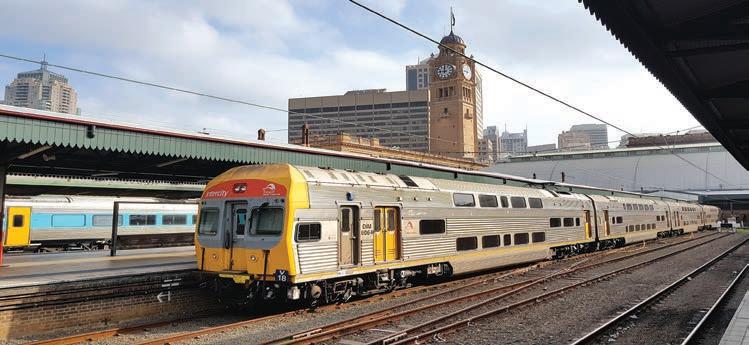
the line, as we step into a new era with our Mariyung fleet,” Longland said.
“It’s the beginning of a new one — one that will deliver a more comfortable travelling experience for passengers,” he added.
The Minns Labor Government has announced its commitment to revitalising rail manufacturing in the region.
As part of the Future Fleet Program, the Government has pledged to begin procuring replacements for the aging Tangara fleet of suburban passenger
trains by 2027. A key goal is to ensure that 50% of the design, construction, and maintenance of the new fleet is sourced locally, creating thousands of jobs.
From 30 June, 19 Mariyung trains will have entered service and be fully deployed on the Central Coast and Newcastle Line, with all 38 local stations able to accommodate a longer 10-car configuration.
V-sets will continue to operate on the Blue Mountains line until they are replaced by Mariyungs, which will also be introduced to the South Coast line after their deployment on the Blue Mountains.
BY LYDIA JUPP
Alarge section of the Powerhouse Ultimo is set to be pulled down and rebuilt after last-minute issues with the $300 million heritage revitalisation plan.
After a competitive tender process, Richard Crookes Construction has been awarded the contract for the renovation, which will see structures inside the Boiler House, Engine House, Power House and Turbine Hall pulled down, the reorientation of the entrance toward Haymarket and the CBD, and the creation of new studios along Harris Street.
Although plans approved in April initially included the preservation of the upper steel structure of the Wran Building and galleries, Infrastructure NSW have confirmed that it would not be strong enough to carry the new brick structure.
“Modification 1 is not about changing the design of the approved heritage revitalisation of Powerhouse Ultimo, it’s about changing the methodology of building it,” a spokesperson told SMH.
“The project remains on time and on budget, and a detailed construction program is currently being developed with Richard Crookes Constructions."
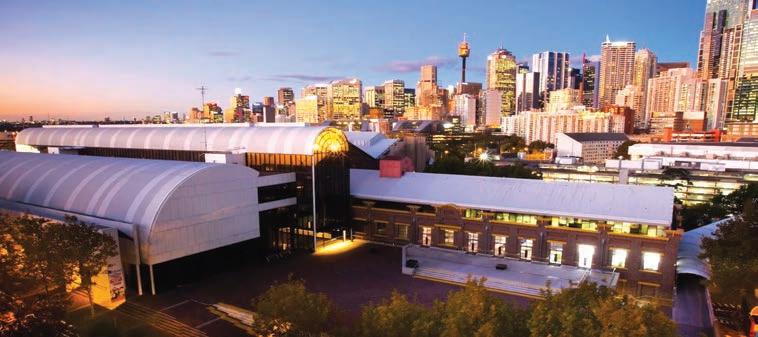
by visitors and the community for decades to come," said Minister for Lands and Property Steve Kamper.
"Keeping the structures is not only unsafe and non-compliant, it would cost the taxpayer more and give a limited warranty on the buildings, which isn’t justifiable given the end product will look the same."
The structure has been deemed ‘end-of-life’, and no longer is up to building codes and standards.
"Importantly the shape and scale of the iconic Wran and Galleria buildings will be safely replaced and futureproofed, so they can be enjoyed
one-stop shop for all your cat care essentials! Stock up on all your feline friends’ favourite treats, toys, food, litter and so much more.
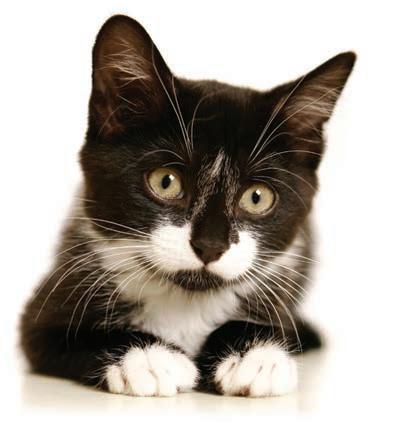
Despite its heritage listing, these lastminute changes have been classified as exemptions under the precinct's listing, provided the site exclusively remains a museum, eliminating the possibility of sale or commercial development.
But the redevelopment has been very controversial, with the museum closing in early 2024 amid protests.
Former Powerhouse Museum Director Jennifer Saunders said in 2022 that the renewal was an “unnecessary wasteful upheaval and demolition”.
"I think this is a form of cultural cleansing, and that Sydney is at risk of turning into a monoculture, all artist studios, contemporary art and function spaces instead of actual collections,” former trustee Kylie Winkworth wrote in City Hub in 2021.
The first stages of construction have begun on the Wran building, with the government expecting a completion date of late 2027 or early 2028.

Names: LARRY, DARRELL & DARRYL, Age: 7 months (est) Sex & Colour: Males White & Black/Grey DSH
MOST
!
These three brothers are bona fide besties and share an unbreakable bond. That’s right, this trio all need to be adopted together! Ever so exuberant and entertaining, these boys are full of energy with plenty extra to spare. Dynamo might just be their middle name so get set to have a hoot. Larry, Darrell and Darryl are ready to rumble up and down your hallway and zoom from room to room in their new forever home. Toys and lots of them are a must for these lively little ones! They may say three’s a crowd, but you’ll find your heart overflowing with love for these fun-loving fellas plus you’re sure to see all your affection and devotion come back threefold. There’ll never be a dull moment with this trio around!
INTERESTED IN ADOPTING? visit www.catprotection.org.au
Rehoming Organisation Number: R251000224
BY TARA ZHOU
The NSW Budget 2025-26 has delivered a mixed bag of outcomes across sectors, revealing clear priorities in housing, education, and cultural investment.
Housing took centre stage in the NSW Budget, with a commitment to deliver 377,000 new homes by 2029. The Strata Community Association (NSW) welcomed the focus on density and infrastructure, noting that over half of new homes will be strata-titled.
“Our sector is not a side note—it is central to achieving the government’s housing targets,” said SCA NSW President Robert Anderson.
The Budget signals growing recognition of strata as a community model requiring tailored planning, streamlined approvals and stronger governance to support liveable, highdensity neighbourhoods for a growing population.
Vulnerable children emerged as key winners in the NSW Budget, with a record $1.2 billion Child Protection Package set to reform the out-of-home care (OOHC) system.
Advocate Zoë Robinson welcomed the move, saying, “This investment is a testament to the bravery of children who shared their stories.”
The package includes foster carer support, caseworker recruitment, and reformed care programs.
“The Special Inquiry showed real reform is not just possible in the future, but possible now,” Robinson added. For the first time in over 20 years, no children are staying in motels or unaccredited care settings.
TAFE received a major boost in the NSW Budget, with $325 million committed to rebuilding its workforce and restoring stability after years of casualisation.
“To have a flourishing vocational
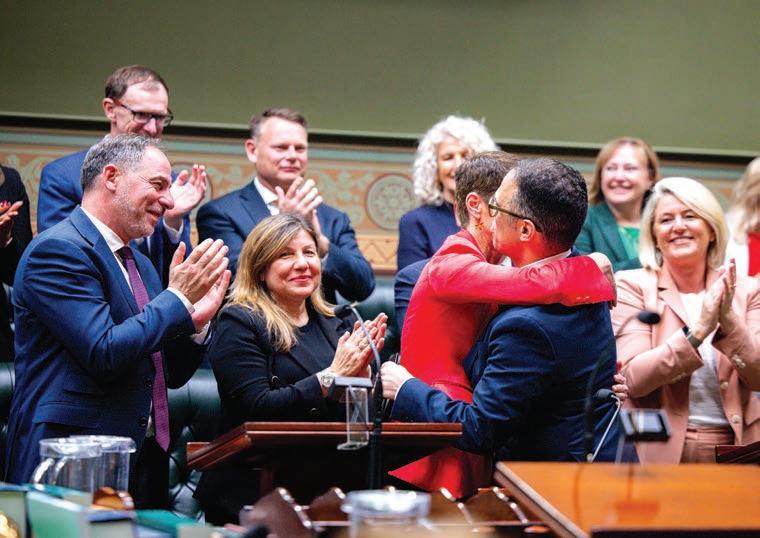
education system, you need a stable workforce of teachers,” said NSW Teachers Federation President Henry Rajendra.
The investment will convert staff to permanent positions and support over 23,000 new apprentices and 4,800 existing workers in construction over two years.
“Investing in skills delivers a powerful return,” Rajendra added.
The move builds on previous efforts, making more than 3,000 TAFE teachers permanent and reinforcing the state’s long-term skills pipeline.
Western Sydney emerged a clear winner in the 2025–26 NSW Budget, with major funding commitments supporting the region’s rapid growth ahead of the Western Sydney International Airport opening in 2026.
“The Airport is coming – and so are tens of thousands of workers and residents,” said Ross Grove, Western Sydney Regional Director of the Property Council.
The Budget delivers $123.6 million for Aerotropolis roadworks and $644 million for stormwater infrastructure.
“This Budget provides connectivity to meet the immediate needs of the region,” Grove added, highlighting its role in unlocking development, housing
supply, and long-term economic opportunity.
NSW’s cultural sector received a major boost, with over $380 million allocated to the screen industry, including $280.6 million for the Made In NSW program and a 10% rebate for post-production work.
A $100 million capital fund will support planning for a second Sydney film studio, while Sound NSW will receive $20 million to advance its 10year Contemporary Music Strategy.
Additional funding will support the state’s nightlife, festivals and regional tourism through Destination NSW and the Office of the 24-Hour Economy, positioning arts and culture as central to economic and social revival.
Nature was left behind in the NSW Budget, with environmental spending falling to just 1.58%—below the longterm average.
“What we’ve been given today is a big zero on new spending on the Great Koala National Park,” said Jacqui Mumford, CEO of Nature Conservation Council NSW.
While $4.2 billion was allocated for
disaster relief, Mumford noted, “We can no longer afford to keep running nature at a deficit.”
Despite rising climate threats, the budget offers little investment in biodiversity or ecosystem restoration, prompting calls to “put nature spending back on the priority list.”
Despite growing need, communitymanaged mental health services were largely overlooked in the NSW Budget.
While billions were allocated to infrastructure, critical psychosocial supports remain underfunded, leaving over 166,000 people without access.
“We have yet to see the Government’s commitments realised in meaningful terms,” said MHCC CEO Dr Evelyne Tadros.
“Let’s stop consulting and use the evidence we already have,” she urged.
Small businesses saw limited relief in the NSW Budget.
“There are dark clouds on the horizon for business,” said Business NSW CEO Daniel Hunter, pointing to rising costs and economic uncertainty.
While measures like the $150 electricity rebate and TAFE investment were welcomed, Hunter warned that 52,000 businesses remain burdened by payroll tax, discouraging hiring and growth. The budget focuses on longterm innovation and infrastructure, but many small businesses were left waiting for urgent cost-of-doingbusiness reforms.
The NSW Budget dealt a blow to Sydney’s golfing community, with $50 million allocated to halve Moore Park Golf Club and convert nine holes into public parkland. The course will be reduced to accommodate new green space for surrounding high-density suburbs. Critics argue the decision disregards golf’s growing popularity and removes one of the city’s most accessible inner-city courses, with completion of the park redevelopment expected by 2028.
BY LYDIA JUPP
The federal court has found journalist Antoinette Lattouf was unlawfully terminated by the ABC, amid complaints concerning her political opinion opposing Israel's military campaign in Gaza.
On June 25, Justice Darryl Rangiah ruled that the national broadcaster breached the Fair Work Act when they sacked Lattouf after an orchestrated campaign against her, only three days into her casual contract hosting Sydney Mornings in December 2023.
"The respondent, the Australian Broadcasting Corporation contravened s772(1) of the Fair Work Act 2009 (Cth) by terminating the employment of the applicant, Antoinette Lattouf, for reasons including that she held a political opinion opposing the Israeli military campaign in Gaza,” Rangiah wrote.
Rangiah did, however, reject the notion that Lattouf was fired because of her race or national extraction, saying “the evidence does not support Ms Lattouf’s claims”.
The ABC has been ordered to pay Lattouf $70,000 in compensation. A hearing on whether pecuniary penalties will be enforced on the ABC is set for a later date.
The Fair Work Act dictates that an employer must not terminate employees for their political opinion or race.
Lattouf was fired after sharing an Instagram post from Human Rights Watch that stated Israel was using starvation as a "weapon of war" in Gaza.
During her testimony in February, Lattouf said the ABC was "flooded with
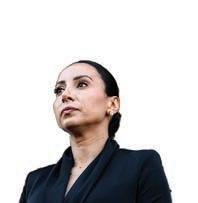

complaints from pro-Israel lobbyists", and she was told to "keep a low profile" online.
Former ABC chair Ita Buttrose told the managing director at the time that she was "over" the complaints about Lattouf.
In 2023… I shared that fact. It's now June 2025, and Palestinian children are still being starved
"I have a whole clutch more complaints. Can't she come down with flu or COVID or a stomach upset? We owe her nothing," Buttrose wrote in an email.
The ABC maintained that Lattouf was terminated for failing to follow
a direction given to not post about the conflict while working for the broadcaster.
Rangiah found Lattouf was “merely provided with advice that it would be best not to post anything controversial about the war,” and was not given a direction not to post.
Outside the court, Lattouf addressed the press, saying, "In December 2023, Human Rights Watch found that Israel was using starvation as a weapon of war in Gaza. I shared that fact."
"It's now June 2025, and Palestinian children are still being starved: we see them every day, skeletal, emaciated, and scavenging through rubble for scraps. This unspeakable suffering is not accidental. It is engineered."
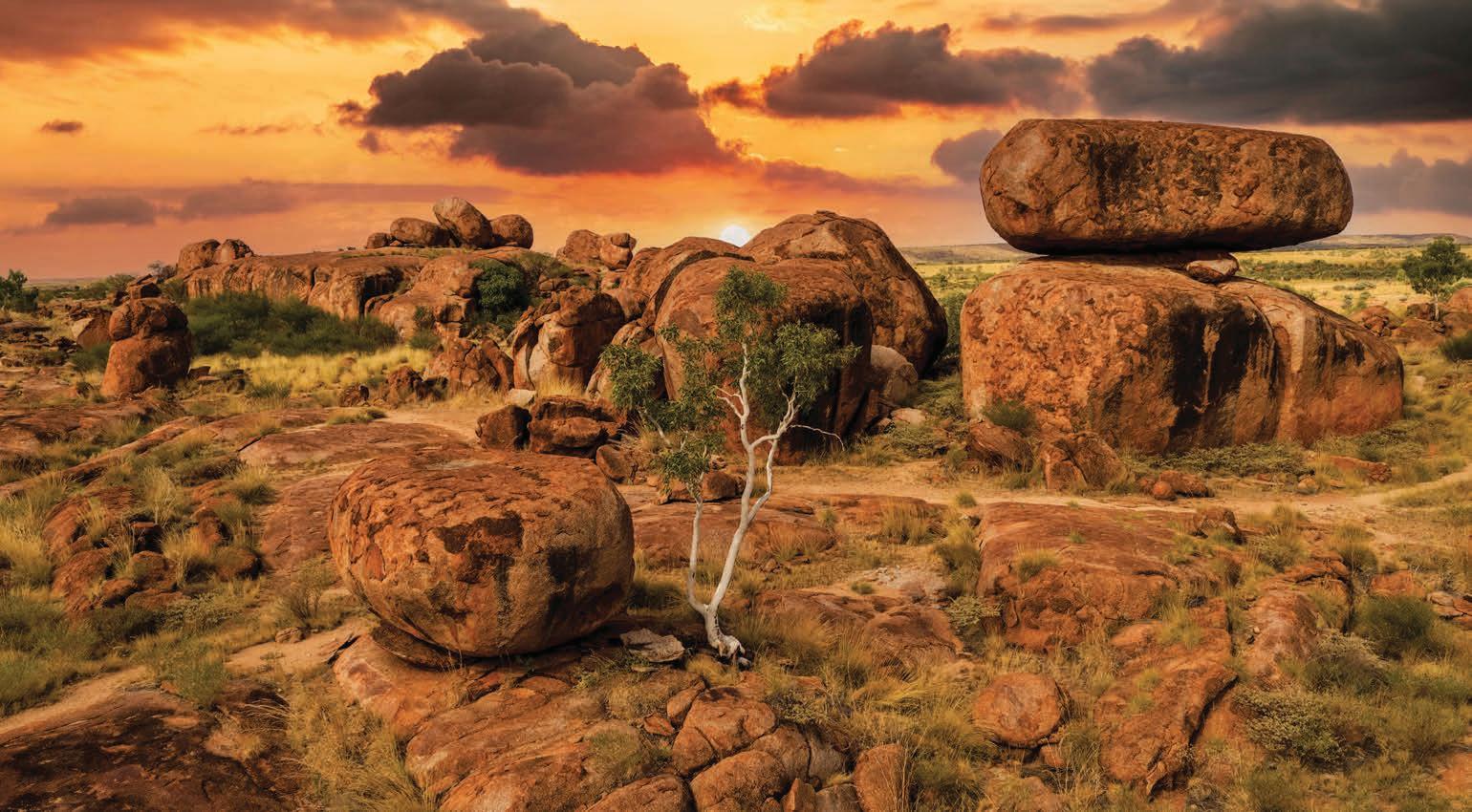




BY LYDIA JUPP
The rapid expansion of New South Wales’ anti-protest laws has been described as “draconian” by many. The recent police violence at a peaceful Palestine action in Belmore at the end of June shouldn’t come as a shock to anyone who’s been paying attention.
Five people were arrested, and a 35-year-old woman underwent emergency surgery after an early morning protest outside of SEC Plating on June 27 turned violent.
Protesters have alleged that SEC Plating is involved in providing plating services for parts used in the F-35 jets Israel is using in its ongoing military campaign against the Palestinian people — claims that the company continues to deny.
Legal Observers NSW, who monitor and report on police action at protests across the state, allege police issued a move on order on the basis that the location of the picket would cause “fear and alarm”, and that the protest was “unauthorised”.
Footage from the morning shows police using “brutal” force on protesters, after they were issued with the move on order. In videos taken by witnesses, police can be seen tackling someone to the ground, while another officer drags a woman by her neck, ignoring calls from picketers to “let go of her, please”. When they finally do release her, she doubles over, violently coughing for air.
The 35-year-old woman is former Greens candidate Hannah Thomas, who sustained such significant facial injuries during her arrest that she required emergency surgery the afternoon following the protest. She may permanently lose vision in her right eye.
Thomas ran against Anthony Albanese as the Grayndler Greens candidate in this year’s federal election, and the extent of her injuries has now sparked a critical incident investigation.
Charged with resisting police, and refusing to comply with a direction to disperse, she is unable to talk to media directly about the protest in detail, but issued a message to her supporters
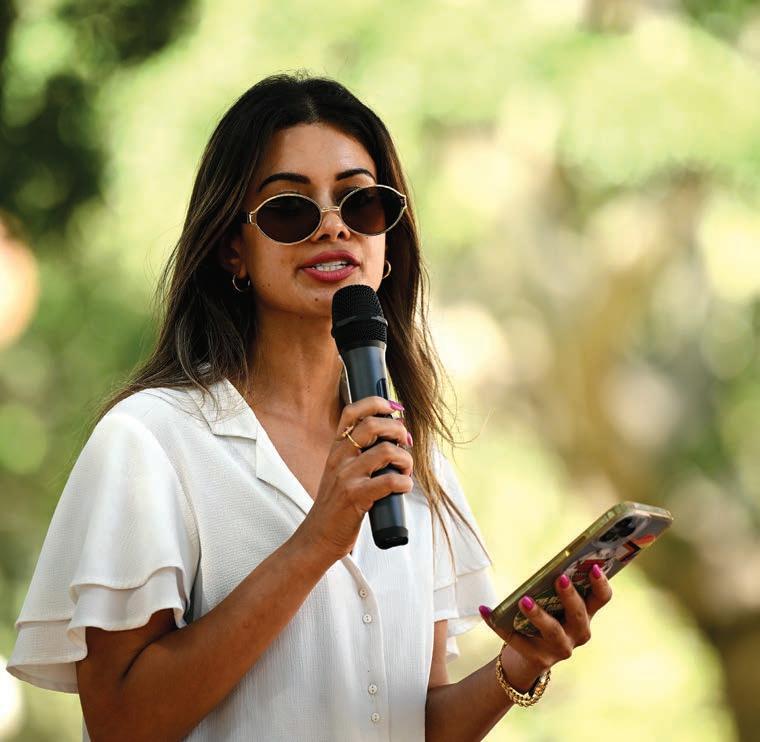
on June 29 from her bed in Bankstown Hospital, with a painful-looking black eye.
“I look like this now because of Chris Minns and Yasmin Catley and their draconian anti-protest laws, and their attempts to demonise protesters, especially protesters for Palestine,”
Thomas said on her social media.
“They’ve emboldened police to crack down with extreme violence and brutality.”
LAWS “A SLIDE TOO DEEP INTO A POLICE STATE”
Greens MP and spokesperson for Justice Sue Higginson says that regarding the anti-protest laws, the writing has been on the wall for some time now.
“The latest tranche of anti-protest laws was clearly a slide too deep into a police state,” she said. “That's the only legitimate way to translate what has taken place.”
Higginson is referring to the state government’s laws against protesting near places of worship, which were passed in
Photo: Dan Himbrechts / AAP
protesters were too close to a mosque across the road. NSW Police Assistant Commissioner Brett McFadden and Minns have both denied this.
Higginson is just one of the voices calling for a constitutional challenge into the laws.
“Police just should not have powers to that extent where they collide with the ultimate right of the freedom to express political communication, including the right to assemble and protest on public land,” she says. “They believed, and they acted, on the basis that they could just bust up a peaceful protest, that they could issue a move on order, and then they could start exerting excessive force.
“If we just look at this one incident and treat it like an isolated incident… this will happen again, and it will happen again, and it will happen again.”

an attempt to curb antisemitic attacks on synagogues throughout Sydney. However, it was an anti-Zionist protest outside of the Great Synagogue on Castlereagh Street on December 4 that pushed Minns to action.
Beyond politics… it's about the movement of peace and democracy in Australia
Organised by activist group Stop the War on Palestine, protesters were rallying against an event being held in the building by Technion Israel Institute of Technology, a company reported to be implicated in Israeli weapons research and development.
It was these laws, police cited on the fact sheet of a Belmore arrestee, that gave them the justification, because
Now, the laws are being challenged in the NSW supreme court by the Palestine Action Group, and Greens MP Kobi Shetty introduced a bill to repeal them back in March. The next few months will be instrumental in deciding whose voices the government values most: that of the people, or the state.
“Beyond politics, this is about those people in positions of power with responsibility, and it's about the movement of peace and democracy in Australia. People right now in those positions of power are following a very dangerous narrative,” Higginson said. “We’ve got two choices. We either slide all the way to the bottom… or we stop now, and we start walking back up the hill together to a place where our democracy is seen for what it can be.”
City Hub reached out to NSW Police for comment, but did not receive a response by time of publication.
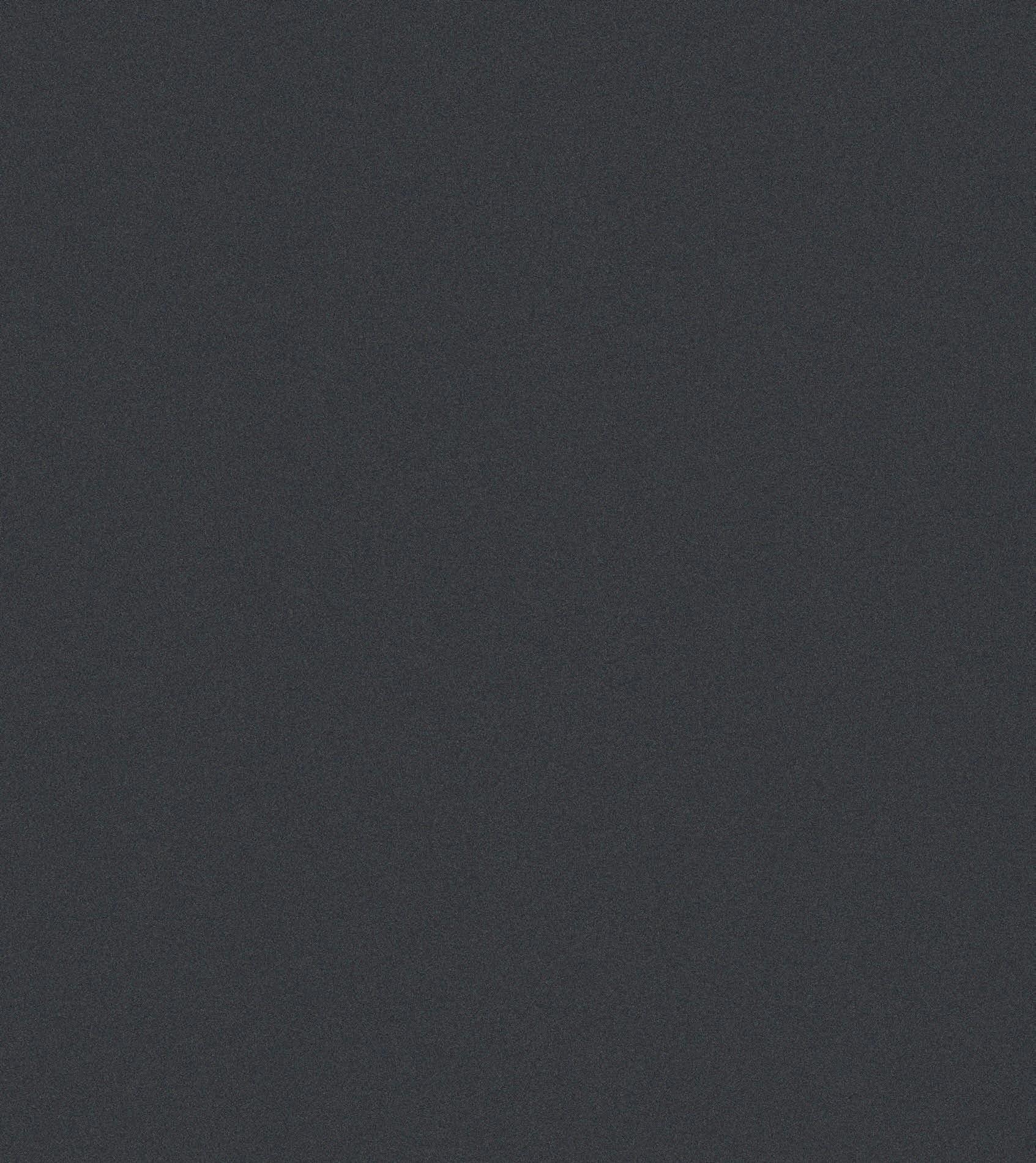
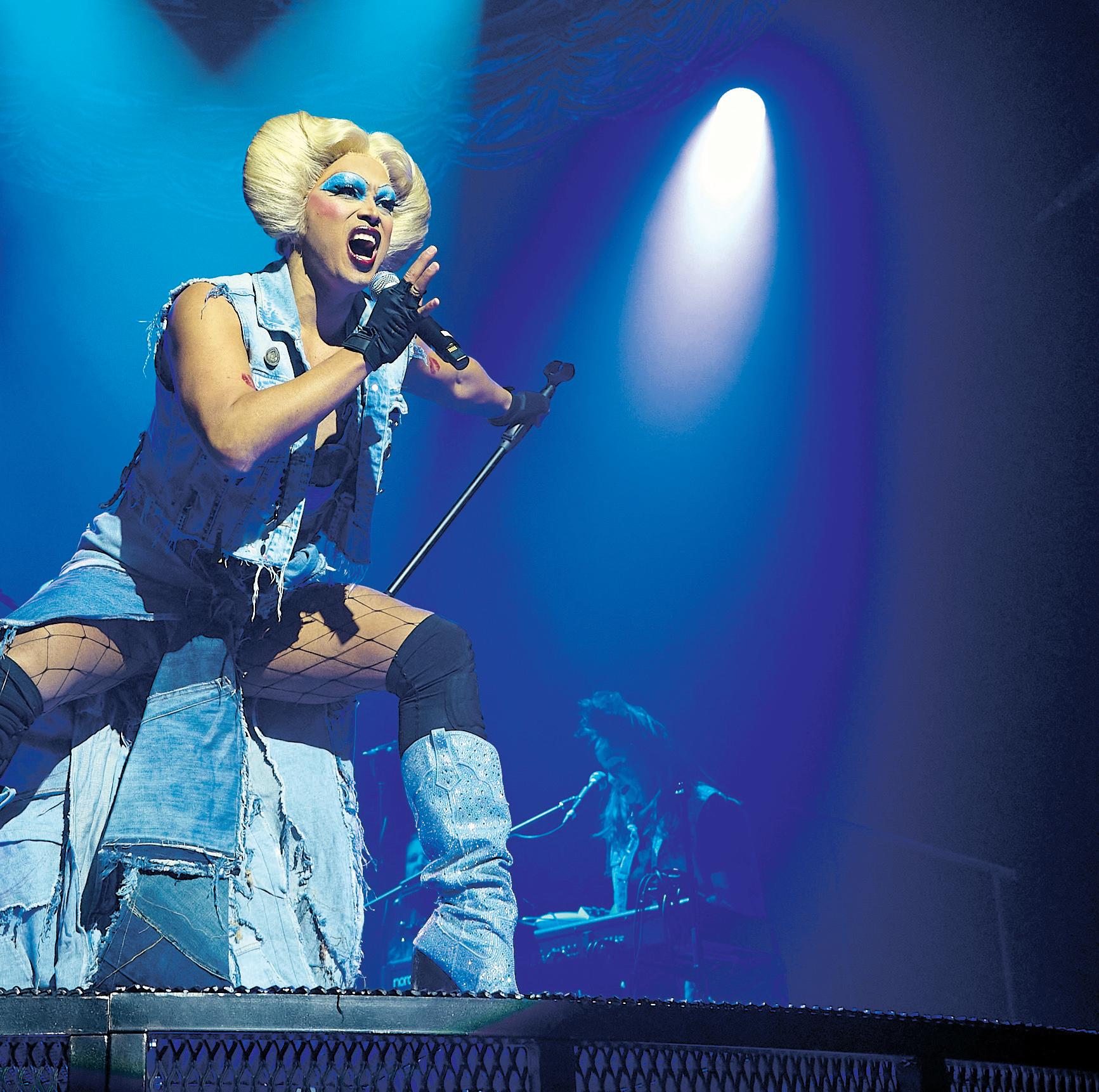

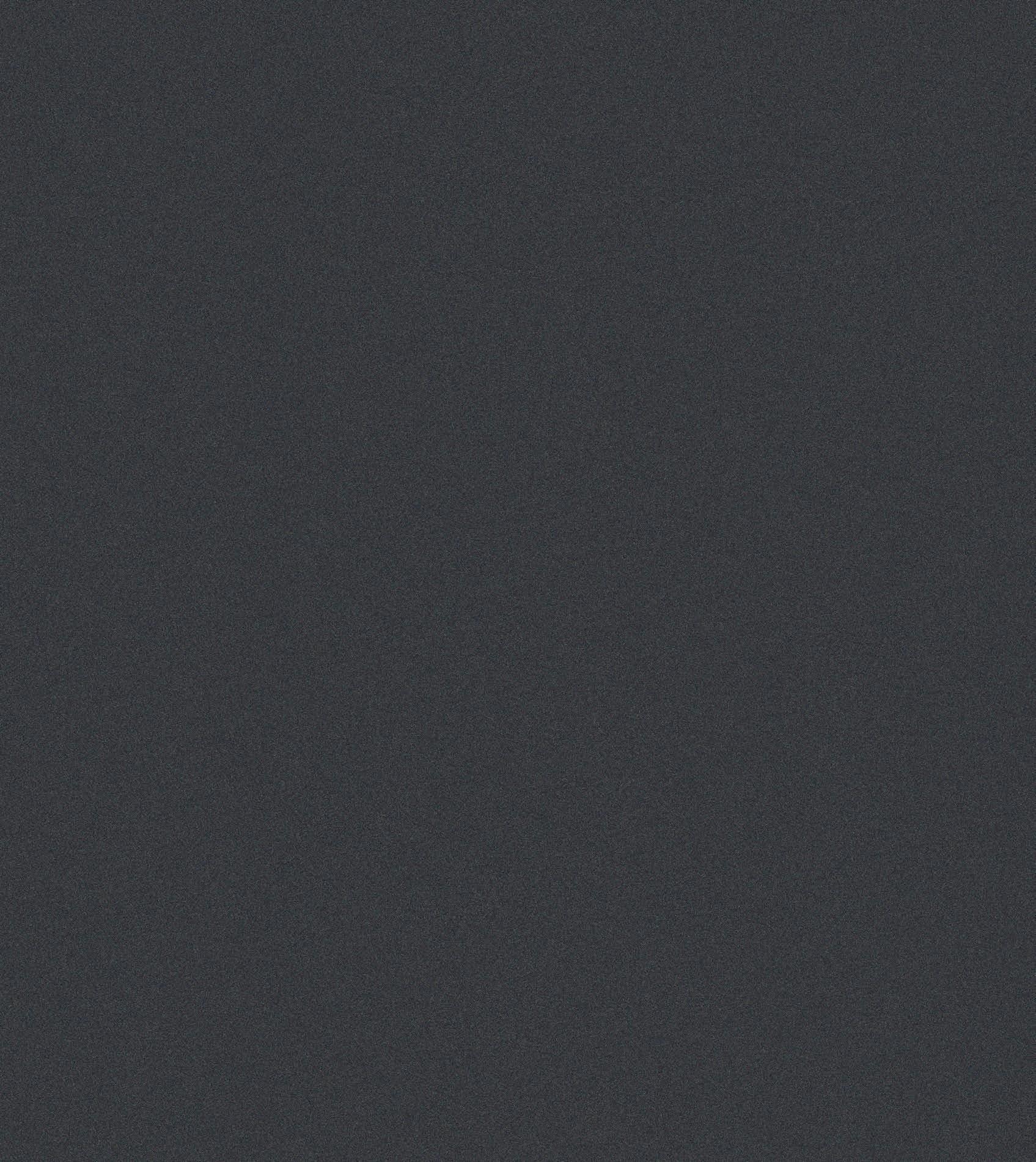
BY TARA ZHOU
Following the release of the state budget, NSW’s key arts agency
Create NSW will undergo major restructuring.
This includes a 25% cut in staffing — prompting concerns about the state’s future capacity to support and fund creative industries.
The job losses are expected to mainly affect the infrastructure division, which previously oversaw major projects including the Sydney Modern Gallery, Opera House Concert Hall, and the Walsh Bay Arts Precinct.
NSW Arts Minister John Graham said in a statement that the millions saved in administrative costs would be reinvested in frontline projects and audience engagement, framing the move as a response to ongoing post-pandemic pressures.
“We’re refocusing Create NSW,” explained Graham. “It will be focused on supporting the people in the arts, culture
and creative industries – the people creating great work and working with the sector to develop new audiences.”
However, the cuts have drawn criticism. NSW Greens spokesperson Jenny Leong MP warned that the decision could harm the sector’s long-term sustainability.
“This is a terrible blow to our cultural life and to our ability to tell Australian stories, with savage cuts to key arts organisations and to our emerging artists which will impact on us all for decades to come,” Leong said.
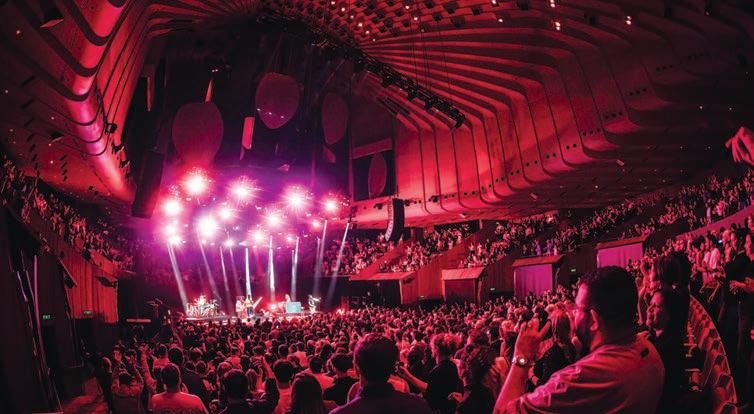
Despite the reduced funding for Create NSW, the state budget boosts total spending on arts, culture and sport to $1.37 billion.
She also noted that smaller, communitybased groups are particularly at risk, as they often serve as vital platforms for new artists’ early-stage work.
“By gutting the companies that support emerging artists, the Government is destroying the future of the industry.”
The government has stressed that the reforms reflect a shift in focus—from building infrastructure to activating it with content and audiences.
Significant investments in film include a $100 million capital fund to develop a second film studio in Sydney, $280.6 million to support local and international screen productions, and more.
Sound NSW will receive $20 million to implement the Contemporary Music Strategy, aimed at building Indigenous and local artist capabilities, supporting venue sustainability and promoting fair pay for musicians.
However, the lack of dedicated new funding for the visual arts sector has raised fresh concerns.
The changes come amid broader uncertainty for the arts nationally, as federal funding cuts have led to theatre closures and the downsizing of community arts programs, posing further risks to the sector’s resilience.
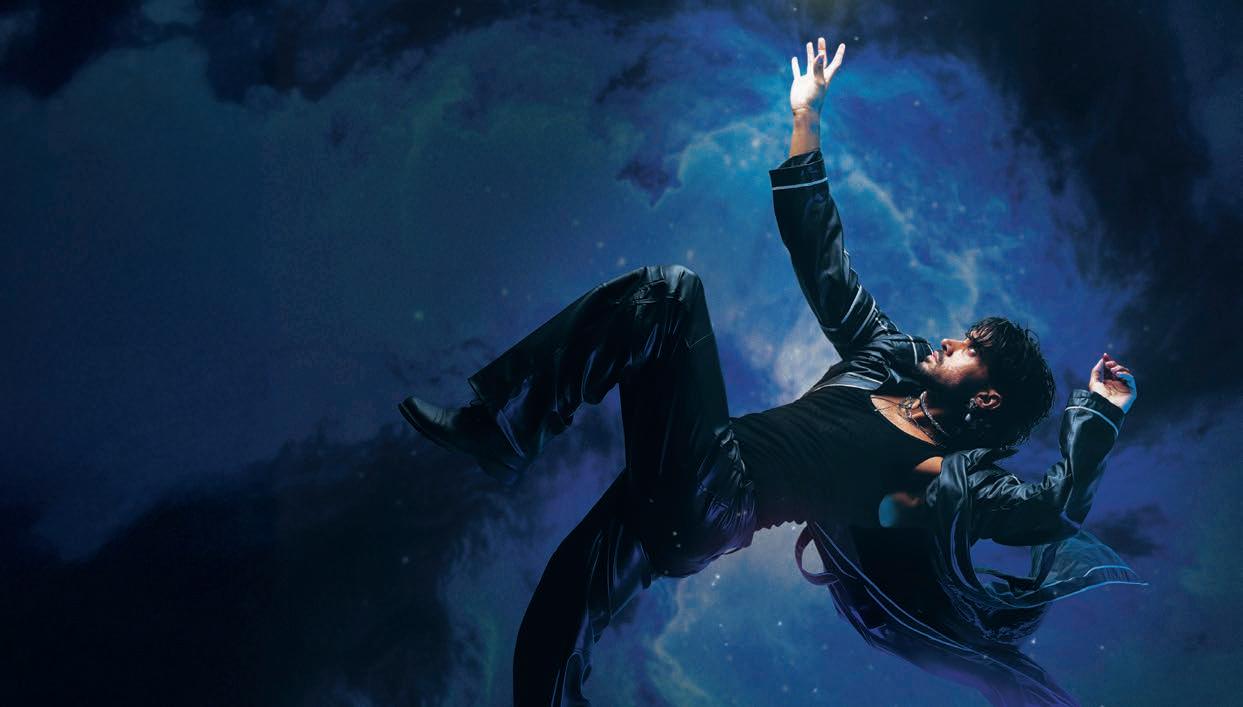
It’s the second most visited website in the world with around 3 billion active users. Every minute, over 500 hours of content are added to the platform.
It’s YouTube of course, and the Australian Government, with all good intentions, is planning to make it inaccessible to the under-16s as part of its social media legislation. Cynics would say good luck with that one!
In November, former communications minister Michelle Rowland introduced the legislation in Parliament, greenlighting YouTube for its “significant purpose to enable young people to get the education and health support they would need”.
Now, on the advice of eSafety Commissioner Julie Inman Grant, it now seems YouTube will also be blacklisted. eSafety admitted that YouTube had many educational uses but “was concerned that the popular use of YouTube among children, coupled with reports of exposure to harmful content”. They went on to add: "Results


from eSafety's recent Youth Survey indicated… 76% of 10–15-yearolds [have] used YouTube, making it significantly more popular than other social media platforms.”
YouTube responded to the impending ban by stating it is not a social media platform; it is a video streaming platform. “eSafety’s advice… is in direct contradiction to the government’s



own commitment, its own research on community sentiment, independent research, and the view of Australian parents, teachers and other key stakeholders in this debate.”
We have yet to learn how the under-16 ban will be enforced, but it seems problematic to say the least. The current guidelines suggest the onus is on the service providers to introduce systems
to block underage people. All sorts of age authentication methods have been suggested, including facial recognition technology.
But it’s no secret under-16s are already circumventing age restrictions and accessing x-rated material on the net. It’s also no different to before the internet, when schoolboys would bring their dad’s naughty ‘girlie’ mags to school to browse with their buddies.
It's an inherent problem when you ban something, particularly in the present day when the internet is an open door to anything, good and evil. When the social media restrictions do come into law, parental responsibility needs to play a major role.
There’s a nasty side to social media and maybe all schools need to devote a few hours a week to discussing responsible use of social media with students.
I’d have no problem if social media disappeared off my screens forever, but YouTube does provide an incredible source of information and archival material.




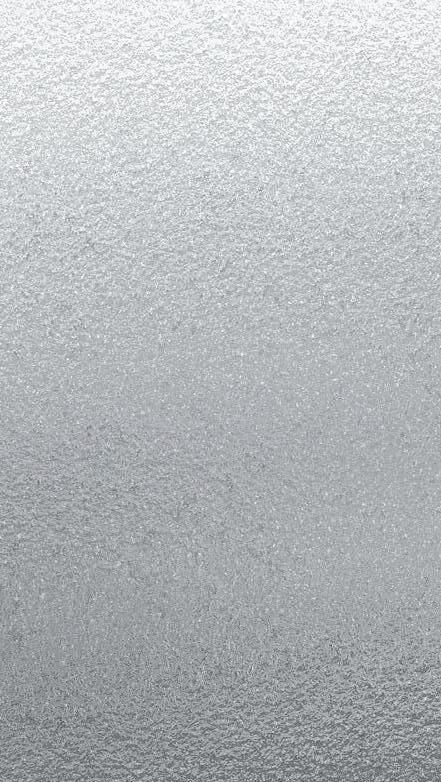












If you're already counting down the days till Sydney thaws out, we’ve got a hot tip for you: ditch the doona and jet north this September. While Sydney still clings to the final chills of winter, Brisbane will be basking in subtropical sunshine — and throwing one hell of a party.
The city’s annual Brisbane Festival is back from 5 – 27 September, and it’s shaping up to be one of the boldest, most beautiful editions yet.
Not just another arts fest, Brisbane Festival transforms the entire city into a giant canvas for performance, colour and connection. Think massive public art installations, mind-bending contemporary dance, lavish cabaret, live music under the stars, and stories that reach deep into the cultural soul of Australia.
It’s one of the country’s most celebrated cultural events, and it’s well worth hopping on a plane for.
Brisbane Festival has been electrifying the River City since 2009, when it emerged as a mashup of two existing festivals — Riverfestival and the original Brisbane Festival — with the goal of turning September into a month-long celebration of all things art, story and spectacle.
Since then, it’s grown into a cultural juggernaut, drawing local legends, international icons and curious punters from every corner of the map. Every year brings a new theme, new faces, and fresh creative risks. But the vibe stays the same: open-hearted, futurefacing, and bursting with a kind of warm, unpretentious fun that’s pure Brisbane.
Let’s start with the glitz: GATSBY at the Green Light is the kind of luxurious, high-drama cabaret you dream about. Brought to you by Caper & Crow, this one’s got sequins, cocktails, variety acts, cheeky bar tricks and a roaring ‘20s aesthetic that’s all killer, no filler. It’s the perfect excuse to grab your most glam mates, book a table, and dress to absolutely impress.

On the other end of the spectrum — but no less dazzling — is Gems, an Australian exclusive and world premiere choreographed by none other than Benjamin Millepied (yep, the Black Swan guy). A contemporary ballet crafted by LA Dance Project, Gems is sublime, intricate and emotionally magnetic. It’s dance, stripped of fuss and bursting with feeling. If you like your dance served with a shot of sweat and sexy rave energy, Bad Nature is your go-to. A blazing collaboration between Australasian Dance Collective, Club Guy & Roni and Studio Boris Acket, it fuses club culture, high fashion and contemporary dance into a high-octane spectacle that grabs you by the collar and doesn’t let go. Other events worth slotting into your weekend: TINA – A Tropical Love Story, the Queensland premiere of Milestone, The Alexander Ball, and Unveiling

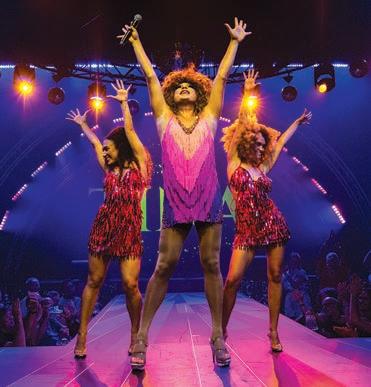
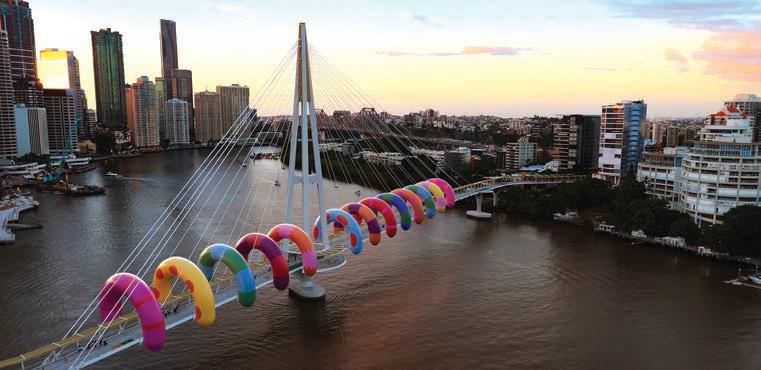
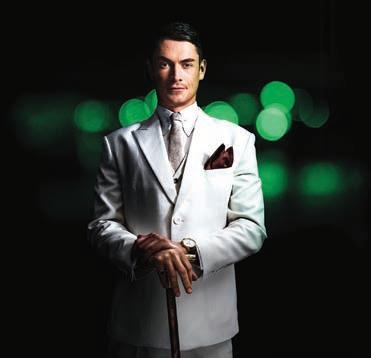
Shadows — each a wildly different expression of contemporary performance, movement and meaning. There’s truly something for every cultural palate.
Beyond the blockbuster shows, Brisbane Festival is a perfect excuse for a mini escape. The weather in September? Dreamy. The city itself? Walkable,
welcoming and buzzing with energy during festival season.
It’s the kind of place where you can eat street food under a jacaranda tree at lunch, catch a world premiere by sundown, and end your night dancing at a riverfront pop-up bar.
If you’ve been meaning to visit Brisbane — or just need a cultural circuit-breaker — this is the moment.
Fly in Friday morning, catch a matinee or evening performance, and spend the rest of the weekend soaking in the vibes. Most venues are clustered around the CBD, South Bank and Fortitude Valley, so you won’t be wasting time (or Uber money) dashing from show to show.
So pack a weekender, ditch your winter coat, and treat yourself to some sunshine and sparkle. The Brisbane Festival is calling — and honestly? It’d be rude not to answer.
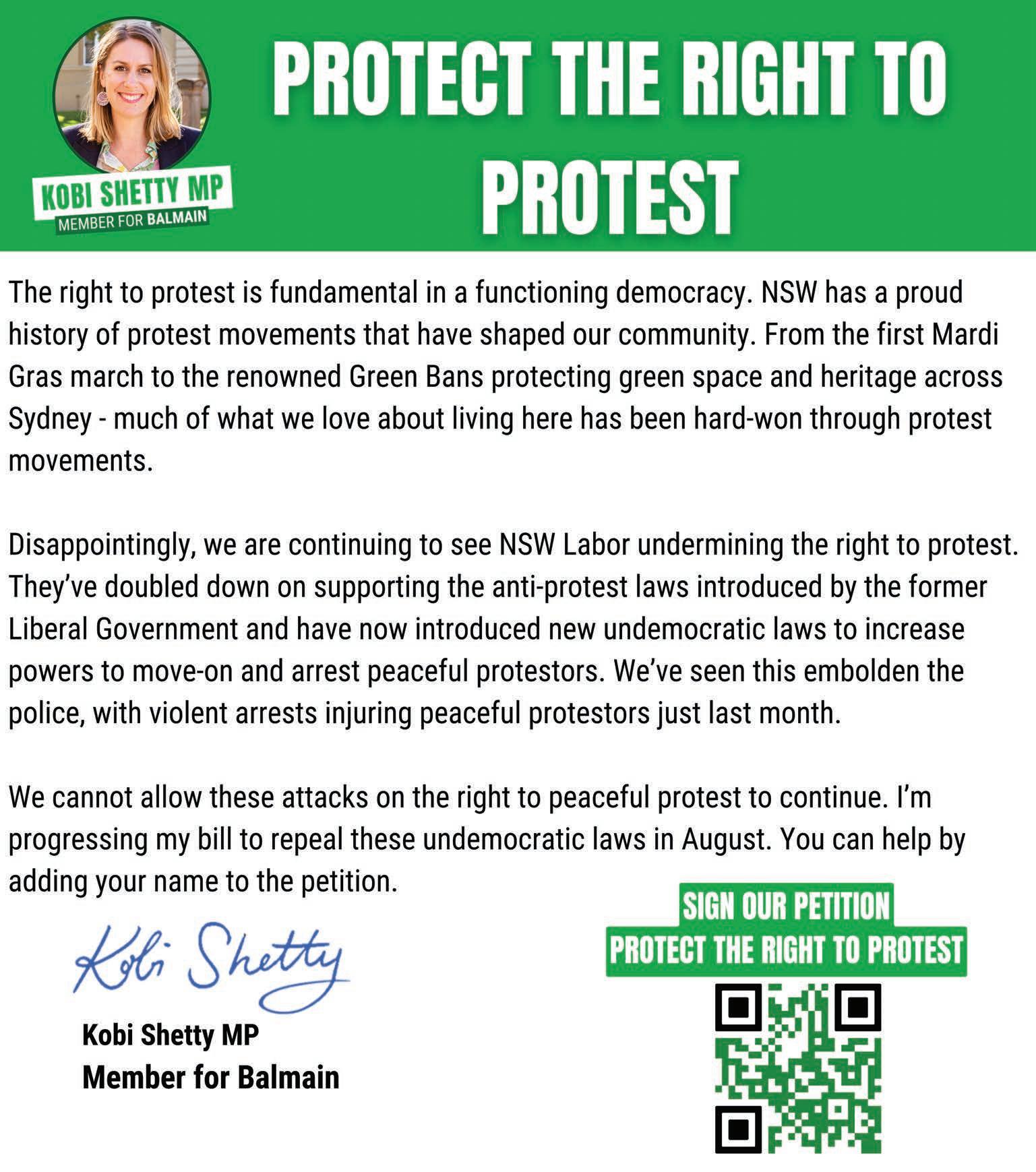
BY JOSH KERWICK
For over four decades, Cats has been a musical made by insane people. Based on a T.S. Eliot poem book and with music by Andrew Lloyd Webber, its particular brand of musical theatre extravagance paired with its baffling story and strangely horny energy has been wowing and dumbfounding audiences across the globe for 45 years.
Compared to the disgusting hairball that was the 2019 film adaptation, watching Cats on a stage is a much better experience.
Cats is all about the craft of musical theatre and taking it to the utter heights of impressively extravagant choreography, and this Australian revival
production achieves that, in what’s sure to be a hit among Cats mega-fans with remarkable staging, music and performances.
The cast, under the stewardship of director Trevor Nunn and a talented team of creatives, are truly a rather exceptional bunch of performers. Cats is nothing without a good Grizabella singing her heart out on the utterly spellbinding Memory, and you can rest assured that Gabriyel Thomas absolutely nails this song.
Most other characters and performers get their time to shine, Todd McKenney as Asparagus, Leigh Archer as Jennyanydots and particularly Des Flanagan as the most raucous character in the show, Rum Tum Tugger.
However, I left especially impressed by Alex Alvarez’s turn as Mr. Mistoffelees at the climax. With an ability to do seemingly endless pirouettes and command attention without even singing, it makes the song Magical Mister Mistoffelees one of this show’s most compelling moments.
These individual moments of brilliance perfectly showcase why people love Cats. Rarely are musicals afforded such a lethal overindulgence of camp sensibilities — it’s a musical so camp that it almost stops being so.
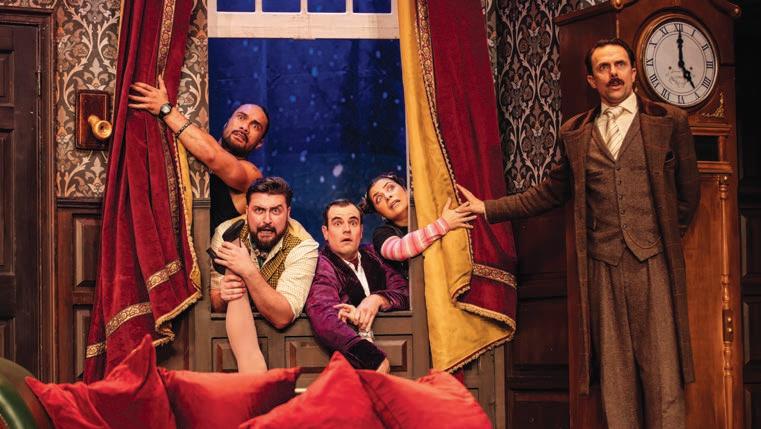
BY JOSH KERWICK
How ironic that The Play That Goes Wrong is likely to be one of the most tightly composed pieces of stagecraft to hit Sydney stages this year.
Walking into the theatre, it’d be easy to mistake this for any other murder mystery play. Yet soon, it reveals itself as a carefully constructed series of dominoes that seem destined to fall in the most malevolent way possible.
The Cornley Drama Society are a woefully unlucky group of theatremakers. Usually vastly understaffed, they’ve received an unusually high amount of money and talent to bring a 1920s murder mystery
The Play That Goes Wrong begins its almost lethal bout of hilarity from the moment you sit down. But only by understanding what makes good theatre can you make it deliberately ‘bad’ — it’s clear that this is a cast and crew with lots of love for the artform, who relish the opportunity to create laughs by eschewing its rules.
In its intentional mistakes and hilarious cast, it reveals itself as a lovingly crafted and uniquely theatrical work that reminds us why we love theatre in the first place.
Playing at the Sydney Opera House until August 3.
M3GAN 2.0
The unexpected gay icon is back (See p.22)


There’s no denying that for better or worse, there’s truly nothing else like Cats. And if you’re planning to revisit it, even with very few surprises for fans or critics alike, doing so in the best possible setting at the Theatre Royal is a damn fine way to do it.
Playing at the Theatre Royal until September 6.
BY MARK MORELLINI
I nternationally acclaimed Australian illusionist Michael Boyd has travelled the world mystifying audiences, and now he comes to Sydney to present Mystique – A Journey Beyond Reality Born in Melbourne, Boyd was introduced to the world of magic at a young age by his grandfather.
“Everything changed when I discovered my grandfather had been a touring magician in the 1930s. From that moment, he became my hero. He taught me the craft, but I truly believe magic is in my blood,” he explained.
In Mystique, audiences can expect to see amazing escapes, transformations, inexplicable disappearances and levitations.
“Mystique weaves a thread of storytelling through the world of dreams—my dreams, your dreams, and the dreaded nightmares. It’s a journey beyond imagination,” enthused Boyd.
“We take the audience on a magical roller coaster—through beautiful moments, whimsical touches, and edge-of-your-seat thrills.”
“The best part of my job is witnessing the reactions—when kids turn to their parents and ask, ‘How did they do that?’ and the parents, just as amazed, say, ‘I don’t know.’ Magic is one of the few art forms that truly ignites a sense of wonder, and I absolutely love watching that wonder light up their faces.”
Playing at the State Theatre on July 11.

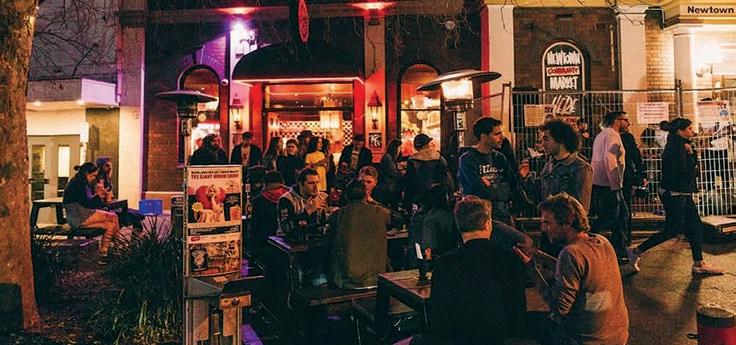
BY LYDIA JUPP
The Inner West will be getting six new special entertainment precincts, with parts of Rozelle, Marrickville and Dulwich Hill joining the likes of Enmore Road in an attempt to revitalise Sydney's nightlife.
The Inner West Council voted to implement the new zones along Marrickville Road and New Canterbury Road in Dulwich Hill, Marrickville and Illawarra roads in Marrickville, the industrial area near Addison Road, and Leichhardt’s Norton Street and Parramatta Road.
bars a big shot in the arm to take us to the next level."
Byrne said that the introduction of a special entertainment precinct along Enmore Road in 2022 was still "going gangbusters", becoming so successful that the council voted to make the changes permanent.
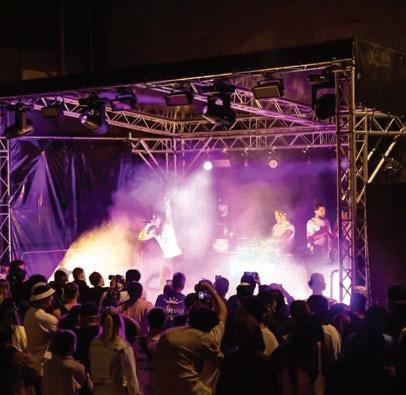
Bars, clubs, and restaurants along these areas will be able to trade until 2:00am on Fridays, Saturdays, and before public holidays, and can keep outdoor dining open until 11pm. Businesses will also be able to host small-scale live performances without needing a development application.
"The Inner West is rapidly overtaking the CBD as the epicentre of entertainment in Sydney," said Inner West Mayor Darcy Byrne.
"Our main streets are already the coolest nighttime destinations in Sydney and the new Entertainment Precincts will give our artists, pubs, restaurants and
BY JOSH KERWICK
The artistic practice and culture of the Aboriginal artists living in Yirrkala, Arnhem Land is the star of the Art Gallery of NSW’s latest blockbuster exhibition Yolŋu Power: The art of Yirrkala, showcasing decades of artwork and representing thousands of years more.
Presented in collaboration with the Aboriginal-owned Buku-Larrŋgay Mulka Centre in Yirrkala, over 300 works from this small group of internationally renowned artists are now on display at the Art Gallery’s Naala Badu, with the kinds of works ranging from bark paintings to metalwork and an installation in the Nelson Packard Tank.
art from Arnhem Land is, and I hope this exhibition presents those works that they may expect to see, but also potentially opens their eyes to other artists doing incredible things.”
There’s no single kind of artistic practice on display in Yolŋu Power. With vibrant bark paintings, wood carvings and statues made with metal recovered from Country on display, the depth of Indigenous artistic practice from this community of creatives is given the space it deserves in the Art Gallery of NSW.
"While other Councils are shutting down entertainment, we are doing the opposite and want to attract more venues and performers to our main streets."
"We are about to see a genuine renaissance of Sydney’s nightlife based here in the People’s Republic of the Inner West.
"We are asking the NSW government to gazette these new precincts immediately so we can help breathe new life into Sydney’s hospitality scene."
Following the success of the first special entertainment precinct along Enmore Road, the Inner West Council have introduced the rules in Balmain, Dulwich Hill, Leichhardt, Marrickville North, Marrickville Town Centre, and Rozelle.
Burwood and Fairfield are both also set to receive their own special entertainment precincts later in the year.
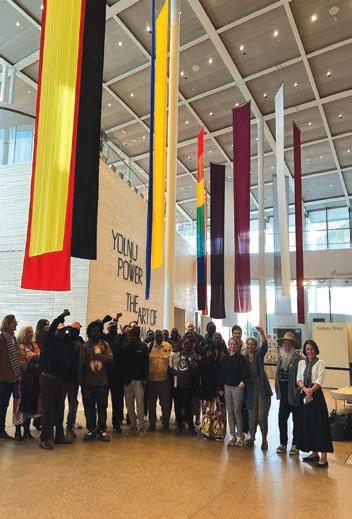
Cara Pinchbeck, who’s the exhibition curator and Head of First Nations Art at the Gallery, says that Yolŋu Power has been a long time coming. “We’ve always wanted to do a big show based on Yirrkala and its history,” she says. “We’ve spoken to the art centre there for many years, and eventually it was scheduled and shaped into the exhibition it is today.”
“I hope what the exhibition does is really show people what the practice of art in a small community full of artists is like over a certain period of time,” Cara says. “I think often people have a perception of what Aboriginal
Bringing a blockbuster exhibition of Aboriginal works with Yolŋu Power to the Art Gallery is absolutely vital to Cara: “It’s really important that institutions like the Art Gallery do substantial projects based on First Nations art, and do that by working closely with Aboriginal owned and run art centres.
“You look at how important these organisations are within these communities when it comes to supporting artists and sending them around Australia and the world, and I think it’s something that’s integral to what all institutions in Australia can do.”
Yolŋu Power is a ticketed exhibition at the Art Gallery of NSW until October 6

BY SEAN CEREXHE-MCINTYRE
I
t’s Friday night at the Marrickville Bowlo and a building crowd is here to see a three-punch instalment of punk music: Gee Tee, Pleasants and Ghoulies. Our headliners for the night are local egg punk specialists Gee Tee, led by Kel Mason. Pleasants and Ghoulies are both over from Perth for a joint run of East coast shows across Sydney and Melbourne.
The egg punk scene in Australia, particularly in Sydney, isone of my personal favourite local scenes. It’s a funny subgenre, marked by its thematic unseriousness. It sounds like fast fuzzy
guitar riffs, highly compressed drums and poppy guitar and synth melodies. Songs are rarely much longer than 2 minutes, and it’s a lot of fun.
Gee Tee has definitely been at the forefront of the Sydney scene, alongside peer bands such as Tee Vee Repairmann and 1-800-Mikey, who are both fantastic in their own right.
As the crowd files in we open with Pleasants, who are a great band to watch live. The four-piece play an old school kind of punk, reminding me of 70’s Australian punk like The Saints. They roll through their setlist at rapid pace, from one 2 minute song to the next.
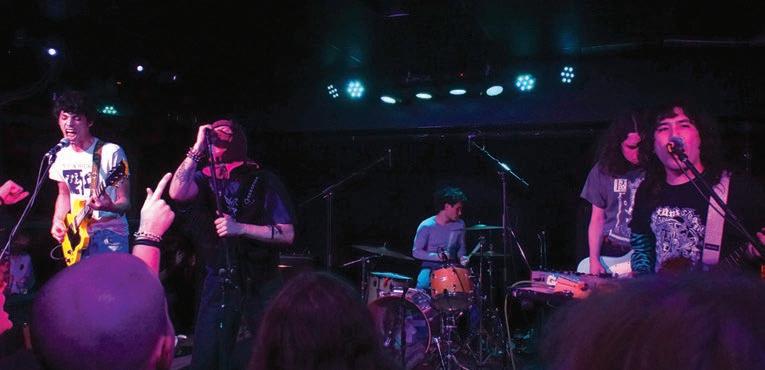
After a short break, Ghoulies take the stage. Interestingly three of their members also played in Pleasants, they just swapped around the instruments. They’re playing a fun, cartoony brand of egg punk, with two different vocalists swapping turns each song. A mosh pit opens up during their set, and I quickly cop a stray elbow to the side of the head.
After a final break between sets, Mason and the rest of Gee Tee emerge. He’s brandishing his trademark pink ski mask that he wears while performing, and quickly gets the crowd bumping into one another at high energy. His live band is an
all-star cast of Sydney’s egg punk scene. They roll through a number of crowd favourites, including Mutant World and (I Hate) Driving in the City. Bodies are flying and someone’s getting picked up off the ground seemingly every couple of seconds. They close with the strong Dudes in the Valley, before making their way off stage after a thrilling half hour.
Gee Tee have a tour of Europe through September and October this year, and you would assume their next Sydney show would be after this.
On their return, they’re definitely one to catch live.
BY SEAN CEREXHE-MCINTYRE
There’s been some fantastic lost musical gems unearthed in the digital age – one of the more recent cases is Jackson C. Frank.
Releasing one lone album in 1965, an acoustic folk masterpiece, Frank’s life story reads like a tragic odyssey. Highly regarded by his musical contemporaries, Frank’s songs fell into obscurity until the mid-late 2010s, since then featuring in films and gaining traction through the internet.
Former Bad Seed Mick Harvey and Australia-based Mexican singer Amanda Acevedo are touring their new collaborative album Golden Mirrors (The Uncovered Sessions Vol. 1), an album of Frank covers.
While Harvey’s musical catalogue is extensive and iconic, Acevedo is a rising singer taken under Harvey’s wing – they’ve now released two albums together.
On their Australian tour, they stopped off at the Vanguard in
Newtown. The venue has recently undergone renovations and technical upgrades, and the space is beautiful. It feels like the kind of smoky burlesque clubs you see in older movies.
Opening is Ed Clayton-Jones. He looks super slick, and his set is a dark, groovy hour, heavy on spoken word vocals, bluesy guitars and thumping cavernous drums. His voice feels like
Lou Reed meeting Gareth Liddiard of the Drones and Tropical F*ck Storm.
He’s eventually told by Harvey to wrap it up as he’s running into the headline set’s playing time, and he promptly obliges to laughs from the crowd. He’s a new discovery for me and an awesome surprise.
When Harvey and Acevedo come out, there’s a lot of back and forth with
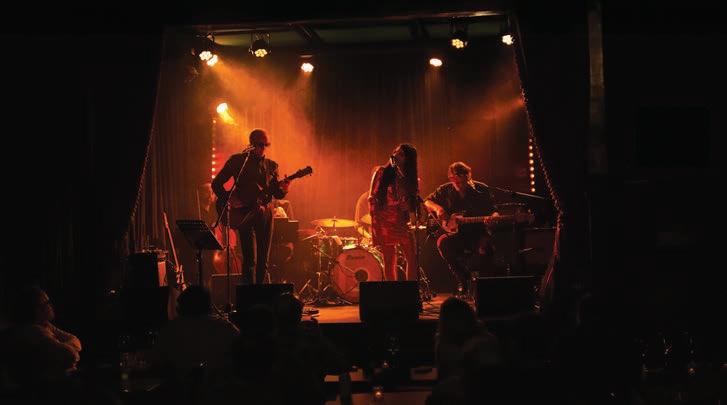
the crowd – it’s hard to tell which of the crowd knows the band personally and which are just longtime fans.
The instrumentations are haunting and lush, featuring a violin and cello among the more conventional rock instruments. Harvey and Acevedo have translated Harvey’s original lyrical monologues into duets, trading verses and choruses back and forth.
You can hear an audible “ohh” from the crowd mid-set when Harvey introduces Frank classic I Want to be Alone (Dialogue). Their cover of Pat Benatar classic Love is a Battlefield is a dreamy interpretation, and their rendition of Harvey original SlowMotion-Movie-Star stands out.
To see them breathing new life into Jackson C. Frank’s catalogue is a great experience, and their interpretations felt true to their own style. Acevedo as a performer complements Harvey well, and it’ll be interesting to see how their partnership continues to progress and evolve.
BY JOSH KERWICK
IPhoto: IMdB
t’s not surprising Danny Boyle and Alex Garland wanted to revisit the world of 28 Days Later. This already highly influential movie where a literal rage virus is unleashed, turning half the population into undead monsters and sending the other half into the depths of depravity, has taken on another meaning altogether post-COVID.
28 Years Later is the third film and the beginning of a new trilogy in this zombie universe. And while it's a promising and entertaining start, Boyle and Garland’s return to their patient zero is deeply unwieldy.
It follows a remote group of survivors living on an island connected to the Scottish mainland. A select few venture out, including Jaime (Aaron Taylor-
Johnson) and son Spike (Alfie Williams), to find the virus has evolved.
However, when Spike discovers his mother (Jodie Comer) is afflicted with a mystery disease, they set out to find a doctor that can hopefully fix her in a world overrun by undeath and rot.
Like most sequels following up on an iconic film, 28 Years Later is extremely messy. It’s part exploration on an enduring community with tinges of COVID and Brexit commentary, part road-trip movie and part full-on infected splatfest across its relatively short runtime.
Part of the film’s scatterbrained story is likely due to the fact that it’s only the first act of a new trilogy. But it doesn’t help that the actual content and direction of the film is a mess, too.
BY JOSH KERWICK
Norwegian cinema maestro
Joachim Trier has achieved greatness again with Sentimental Value, a sincerely remarkable film.
It’s about many things – what we pass onto the next generation, how we communicate through art, where we find meaning in our lives – but never does it feel outright unwieldy.
It follows the Borg family, sisters Agnes and Nora, and the recent death of their mother. Their director father Gustav approaches actress Nora with a script about his own mother, who died by suicide. Drama
ensues – but not in the way you’d think.
What makes Sentimental Value such a knockout effort is the sheer depth of feeling each character possesses. We can thank Trier and co-writer Eskil Vogt, whose multidecade collaboration ensures the script is practically airtight.
Despite the very high expectations set by The Worst Person in the World, Sentimental Value more than exceeded my expectations.
1/2
In Australian cinemas later this year.
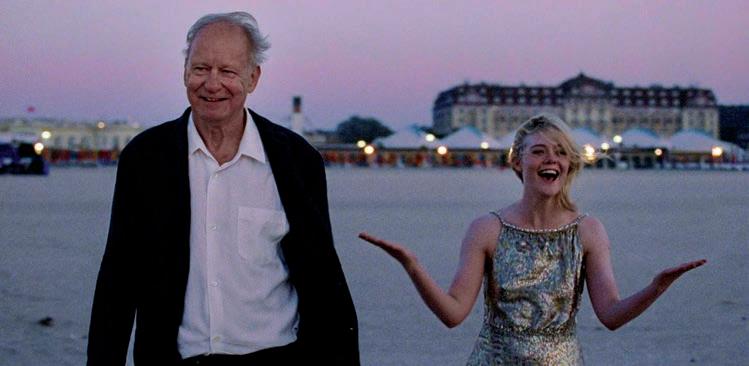
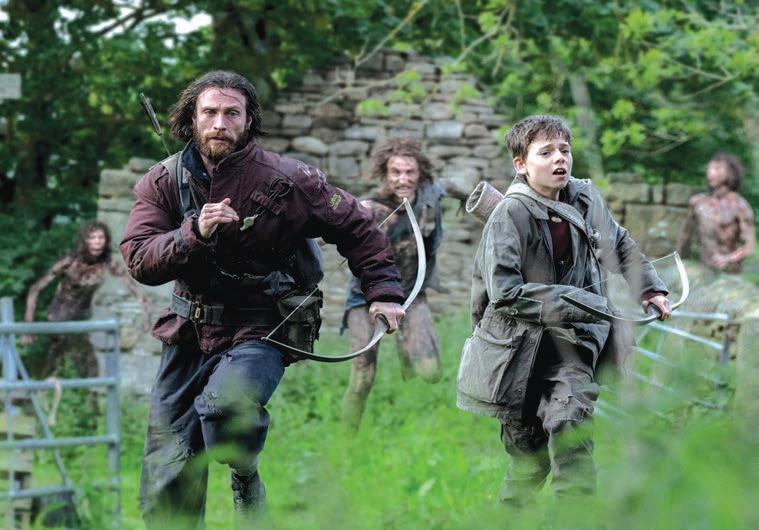
Danny Boyle has long been known for a somewhat frenetic filmmaking style that worked excellently with the camcorder aesthetic of 28 Days Later, and some filmmaking decisions truly baffled me, while others had me admiring the beauty of what Boyle was able to achieve as a director. Where the original film felt like a real
shot in the arm for the zombie genre, this feels measurably more by the books. It’s clear that Boyle and Garland still care greatly about the world they created together, but it’s easy to wish that there was a bit more meat on the bones.
28 Years Later is in cinemas now.
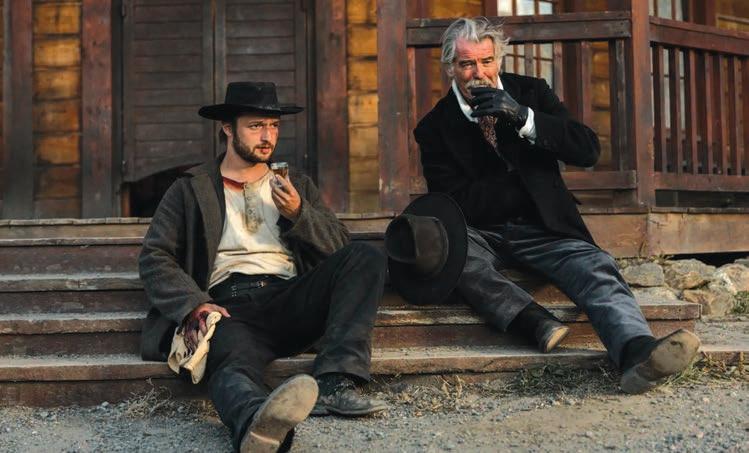
BY MARK MORELLINI
In Montana in 1873, a felon named Isaac Broadway is to be hanged, and he asks his estranged son to ride to a small town named Trinity and kill the sheriff who framed him.
Moviegoers don’t need to be cinephiles to realise when they’re watching films which were ultimately produced for streaming. The budget constraints that have cheapened the film's quality permeate throughout. Both Pierce Brosnan and Samuel L Jackson unfortunately are wasted in this bland western, and audiences
may ask, “Why did they accept these roles?"
The cast all seem to have different accents which are decisively detracting. The overacting by several of the supporting cast also downgraded the production. Being a western flick enthusiast may make this tolerable viewing but seriously, if you must watch The Unholy Trinity, wait until it arrives on streaming platforms.
Limited release in cinema; on streaming platforms from July 16.
BY JOSH KERWICK
M3GAN was one of the surprise hits of 2023, a campy horror-comedy that asked… What if you had a personal killer robot with a sassy attitude who’d do anything to protect you?
Now, the unexpected gay icon is back in M3GAN 2.0, a surprisingly dialogue-heavy piece of speculative sci-fi that doesn’t always work. Nonetheless, it’s easy to appreciate that returning director Gerard Johnstone decided to get kinda weird with it.
M3GAN (Amie Donald & Jenna Davis) is dead. At least that’s what inventor-turned-AI ethics advocate Gemma (Allison Williams) and her niece Cady (Violet McGraw) think before they discover her code lives on in AMELIA (Ivanna Sakhno), a new robot designed by the US government who goes rogue on her first special ops mission.
The raising of the stakes in M3GAN 2.0 is frankly ridiculous. Although the first film was a very camp horror flick, its sequel doesn’t attempt to bring any scares as it changes genres to sci-fi action, where our titular character is trying to save the world from an AI armageddon. They lean into M3GAN’s newly attained cultural status after her dancing and generally hilarious demeanour in the first film. She’s mean, protective and shows a surprising amount of character growth. Donald’s physical performance and Davis’ voice performance collaborate in a
BY JOSH KERWICK
If there’s one thing that’s absolutely incontrovertible about body horror maestro David Cronenberg’s The Shrouds, it’s that nobody could have made this film but him. Inspired by feelings about his own wife Carolyn’s passing in 2017, it’s a deeply bleak work that’s obsessed with bodies in all states whether they’re alive, decaying or dead.
Much like grief itself, this is an unwieldy film that’s difficult to fully grasp and occasionally feels like you’re stuck with it forever.
It’s been four years since the wife of Karsh (Vincent Cassel), a producer of ‘industrial videos’, lost her battle with cancer. To keep watch over her into eternity, he’s created a company called GraveTech which allows paying customers to spectate the transformation of their loved ones into cadavers with 3D scanning.
One day, a number of the plots at GraveTech’s burial site are vandalised,
genuinely fantastic manner, making it easy to remember why the first film was a hit.
The returning cast members are also doing solid work, particularly Alison Williams, while the new additions are hit and miss. Jermaine Clement makes a brief, serviceable appearance as not-Elon Musk and Aristotle Athari is firmly okay as anti-AI activist Christian Bradley. Ivanna Sakhno is quite good as AMELIA, bringing a steel-jawed expression that makes her android status firmly believable.
Unfortunately, it takes a while for M3GAN 2.0 to really boot up. The script takes a long time to set up its new, ludicrously high stakes or even reintroduce M3GAN back into the story, which is a choice that left me a bit confused.
Once M3GAN does properly return in all her audacious, slightly uncanny glory, the film undeniably comes alive.
The story is a little bit nonsense, and has some questionable musings on artificial intelligence. Nonetheless, M3GAN 2.0 is fun. Its unexpectedly competent genre turn and overall absurdity won’t be for everybody, and certainly not for those seeking a hardcore horror thrill. But when you’ve got a character as fun as M3GAN, limiting her to a single genre would only be doing her a disservice. Let her spread her wings.
1/2
M3GAN 2.0 is in cinemas now.
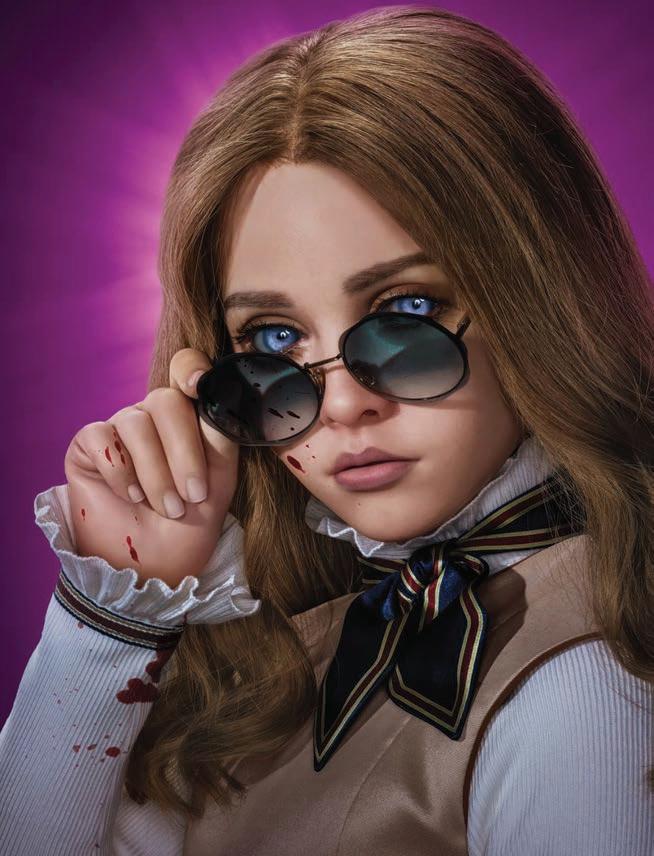
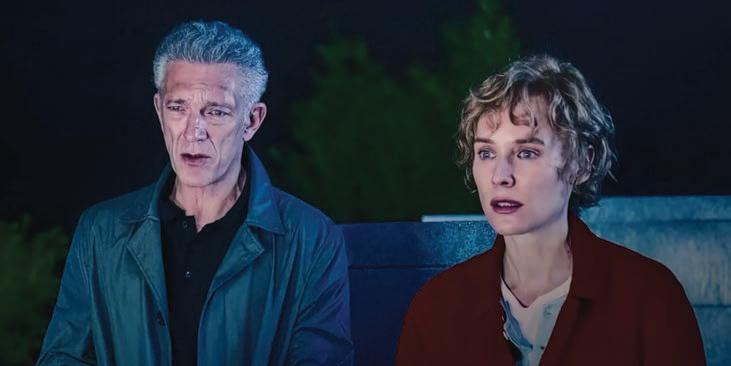
including Karsh’s wife. Along with his sister-in-law, her ex-husband, and a new paramour Soo-min, Karsh aims to find out who vandalised the graves and hold them responsible.
The Shrouds plays on many of the themes Cronenberg has explored throughout his career. It’s a deeply technophobic film, in an even greater manner than Videodrome, albeit in a distinctly very modern way. There’s
arguably nothing more horrifying in 2025 than our main character driving a Tesla.
But unlike his other body horror films, The Shrouds is more focused on what happens after the flesh fades away. Having lost his wife, he feels that he’s lost a physical and sexual extension of himself, having known her intimately for so long. Given the film is inspired by real grief, and that Karsh looks suspiciously like Cronenberg, it’s easy to see it as
one of his most personal films.
Nonetheless, I found The Shrouds odd. I often enjoy Cronenberg films for his utter commitment to a certain idea, and rarely do his narratives feel like they’re stretching their worth. Given its distinct lack of focus and generally slower pacing, it’s a film that feels all over the place.
From the script to the direction and disparate acting styles on display, it never feels like any two people The Shrouds fully understood what they wanted to achieve with the film. Its sleek, digital cinematography makes sense for a movie grappling with technology as a primary theme, but feels too clean for a story revolving around decaying corpses.
There are no easy answers in The Shrouds. In that way, it’s an ample representation of grief as it leaves you reeling for something definitive or a clean conclusion.
1/2
The Shrouds is in cinemas now.
